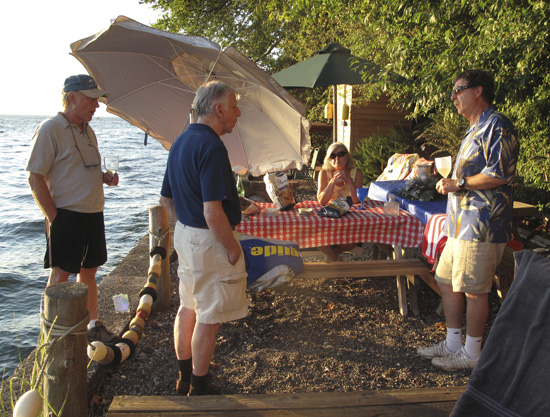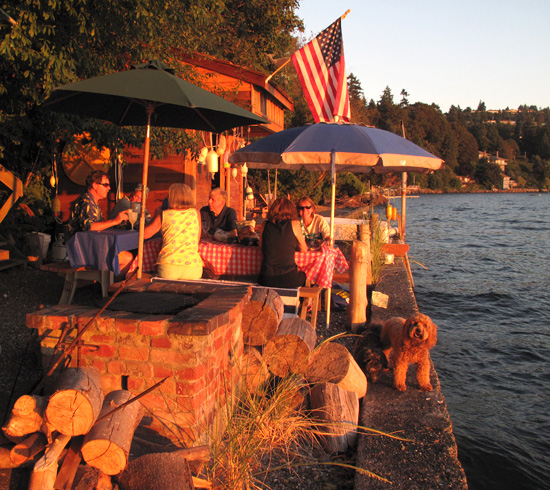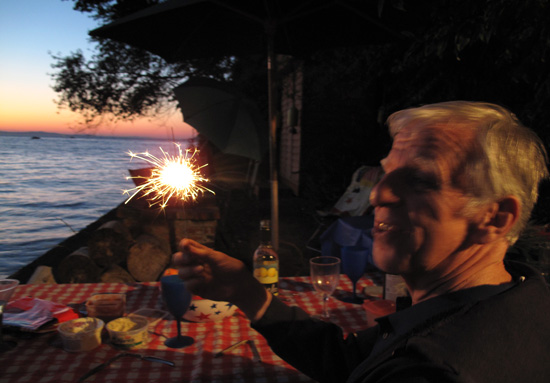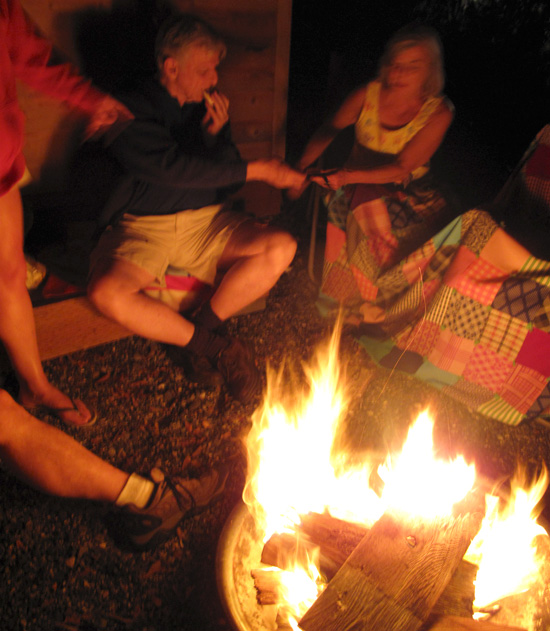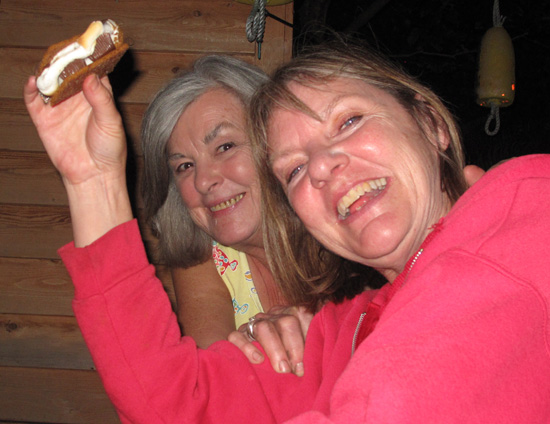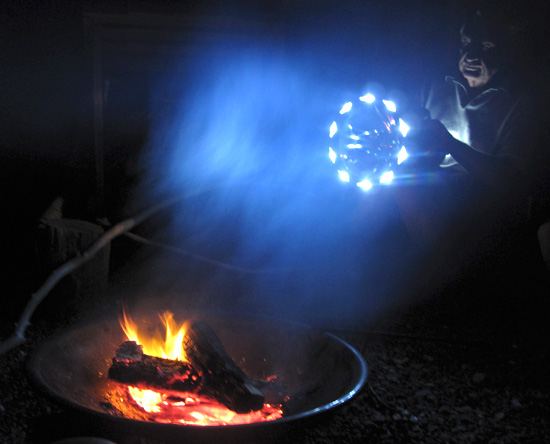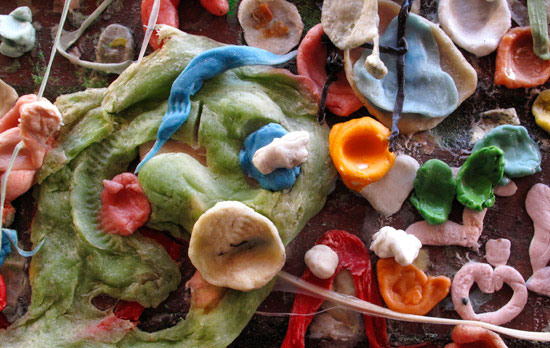
by Maureen | Oct 21, 2010 | Design, Discoveries, Featured Articles, Food!, Incredible Locations, Journal, Meals, People, Photos, Seattle, Shopping & Markets
As a designer and photographer, one of the most stimulating aspects of being in Italy was its visual lushness. Every surface and every structure caught my eye. (Hence, the 16,300 photos I shot in my almost-14-months there!) Before leaving Milano, I told a few friends back home that I was concerned I’d be visually bored once I returned to Seattle.
One friend, David, “The Computer Guy”, offered to take me on a tour of 100 quirky and wonderful things to see in Seattle. It would be a way of seeing Seattle, my birthplace, with fresh eyes. Now that I’m finally coming up for air from resettling, and blessed with blue sky Fall days here, we had our tour last Friday.
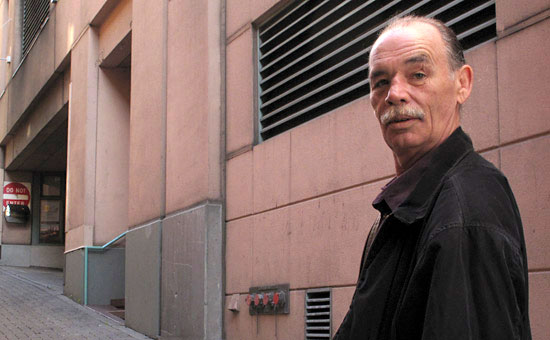
David and I met up at the International Fountain at the Seattle Center, ready to begin our 4-hour, fast-paced whirlwind through the city. (This is a tour he used to make with his son when he was little.)
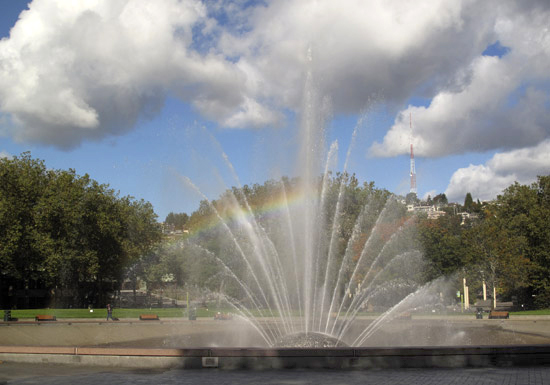
After checking out the rainbow arching over the fountain, we walked through the Center House food court to the Monorail entrance. We bemoaned the absence of the old Bubbleator that used to rise through the middle of the Center House floor.
It’s been years since I’ve taken a ride on the Monorail, and I’ve never made the trip as it now passes through EMP-Experience Music Project/Science Fiction Museum, designed by architect Frank Gehry.
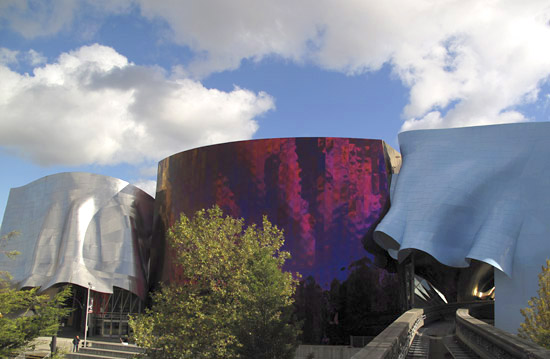
.
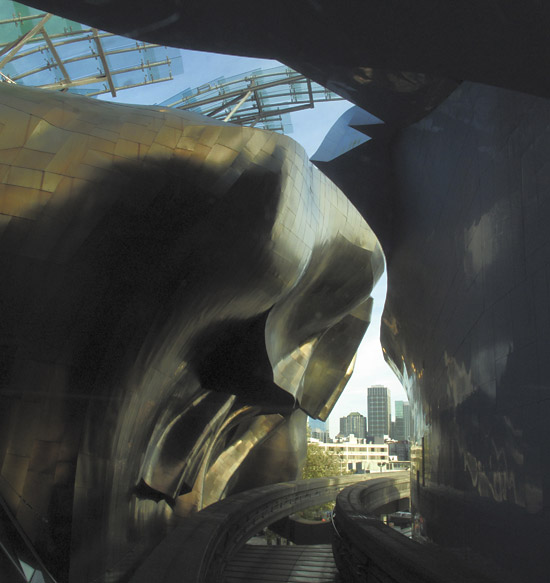
The Monorail’s elevated tracks snake the short distance from the Seattle Center in the lower Queen Anne neighborhood, into the city, past the “Darth Vader” building (on the right, below). (Seattle also has the “Norelco Shaver” and “Ban Roll-On” Buildings, named for their evocative shapes.)
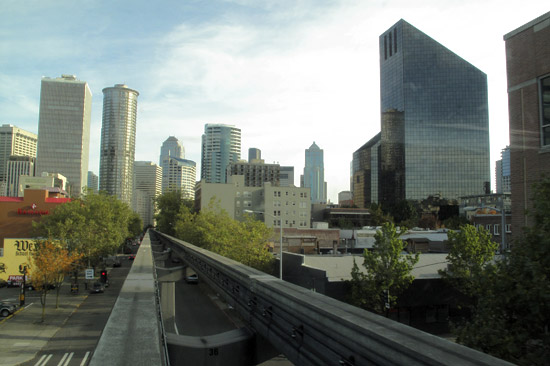
After a short ride, we arrived at Westlake Center, a 4-story shopping hub just a few blocks from the Pike Place Market. We wound through the lunch crowd for a quick pit stop before we began at Westlake Station for our ride through the Seattle Transit Tunnel.
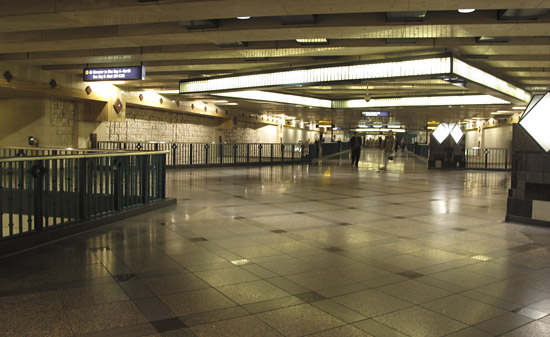
Every tourist and every local should take a free ride through this well-rendered tunnel.
From King County’s Web Site: “The tunnel has five stations. One of the first mysteries of station design was which came first, the art or the architecture? It’s difficult to separate the two. That’s because a lead artist worked with a lead architect to develop the distinctive art and architecture for each station.
“Metro eventually commissioned 25 artists to create more than 30 artworks for the tunnel, stations, surface streets, and sidewalks. The artists worked with Metro’s tunnel project consultant-Parson Brinckerhoff Quade and Douglas Inc. and architecture subconsultant TRA. Together they created the ‘art-itecture’.
“Each station is a representative slice of the neighborhood it serves. The architects and artists wanted people traveling through the tunnel to know where they were below the city by looking at the architecture and design features of the station they were in.
“The designers achieved that goal by studying surrounding businesses, buildings and uses, then creating designs reflecting those elements. Some features are subtle, and others much more noticeable.”
Design and aesthetic details found in the Transit Tunnel are too numerous to list. The roster of artists and architects, and their contributions, is lengthy. There is both “Art with a capital A”, as well as visuals inconsequential to most but artful to me.
(Click through the left-hand side navigation on this Station Art page to read discussions about the art and treatments of each transit station.)
At the University Street Station, beneath Benaroya Hall, is “Saccodoscopoeia” by Bill Bell, perhaps the most intriguing thing I saw all afternoon. Easily dismissed as just a granite wall with vertical rows of LED lights, with a little further exploration, this piece surprises the mind and eye with imagery and words revealing themselves through a “persistence of vision” trick. Move your head back and forth quickly and Seattle-specific icons appear, hovering in front of the wall. David’s trick is to stand 20 or 30 feet away from the wall and twirl on your toes a couple of times. The resulting dizziness causes the eyes to flicker and the images appear readily! (I was amused to think of the security cameras capturing our spinning in circles.)
Here’s the wall, at a glance. When I stood close to the lights and held my camera up, the images flashed quickly in my screen several times, but I wasn’t successful at getting a shot.
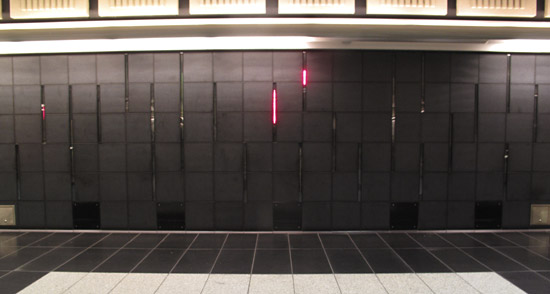
We saw big clocks, distinct at each station and all set to high noon. I appreciated the stenciled compass roses painted on the roadway. How appropriate and helpful for knowing “which end is up”.
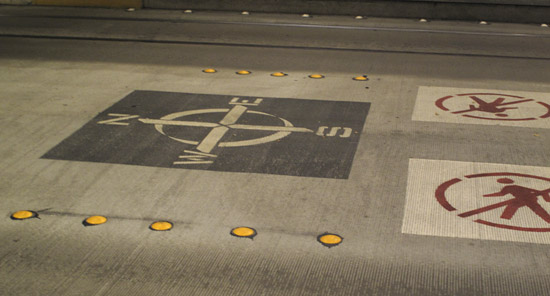
Benches, of course, are all “sit but don’t lie” in their design, discouraging naps and nighttime lodging by those without a better place to sleep.
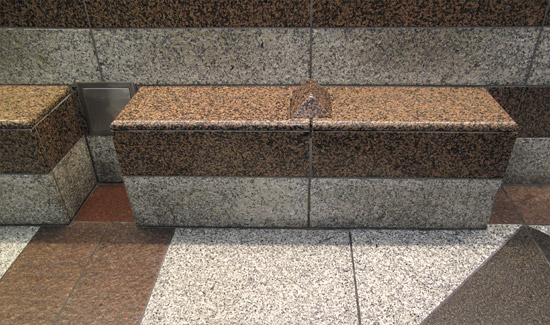
Though each station features distinctly different artwork, one element that unites all stations is the sandblasted braid created by artist, Norie Sato. It’s meant to be part of the cueing system for the visually-impaired, but I found it so subtly low-relief that I question its effectiveness for that purpose. I loved it’s visual addition to the tunnel stations, though. And the varied, patterned stone paving reminded me of what I’ve seen in Italy, France, China and Nicaragua. I’m all for visually-rich floors, sidewalks and roadways instead of monotonous gray concrete expanses.
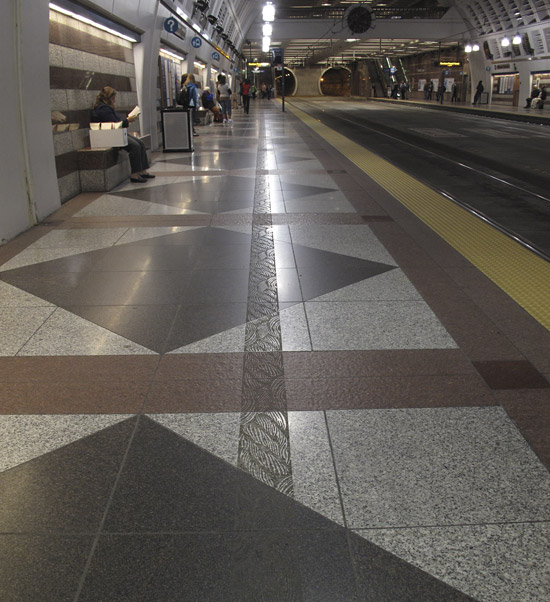
We rode Metro through the tunnel from Westlake Station to the International District, popping up at the other stations along the way. Rising up out of the tunnel at “Chinatown“, poetry was sandblasted into the stair risers. This word “venture” seemed appropriate for our day’s tour.
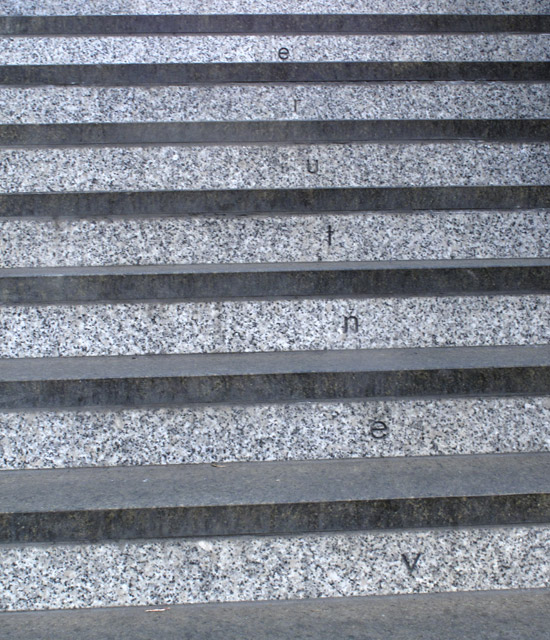
Immediately out of the station, we were greeted into Chinatown by the 45 foot high Chinese Gate, completed in December of 2007, and adorned with the characters saying “Zhong Hua Men”, meaning “Chinese Nationality”. It is typical of the traditional city gates of China and reminded me of a gate I photographed in Xi’an, China, years ago.
We were on a mission, heading to one of David’s favorite spots in Seattle, Liem’s Pet Shop in the Maynard Alley. Unfortunately, they were closed, so there was no visiting with the diverse menagerie.
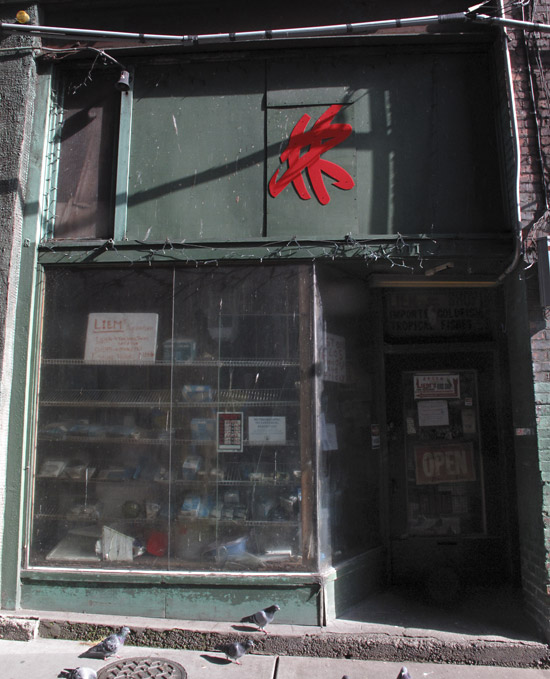
We wandered around, smelling good food, but not stopping to eat. (Why?) We passed the relic of an old dim sum shop and stepped into an art studio and gallery on Jackson Street. The painter’s calligraphy had a sort of Parkinsonian jitter to it, which made it quite distinct.
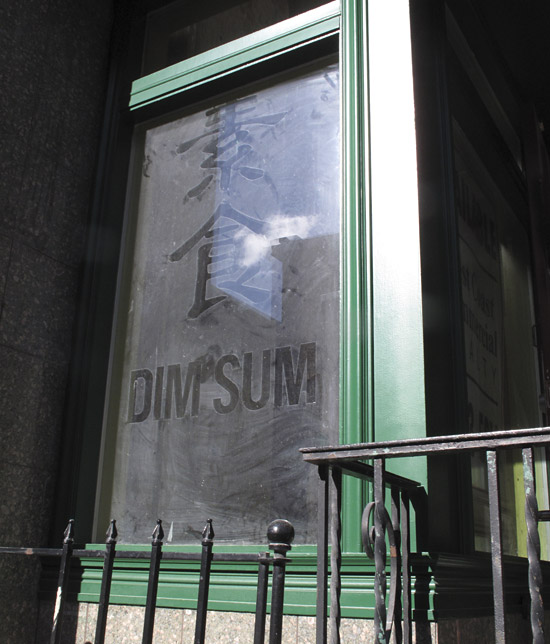
Though contemporary, this poster harkens WAY back.
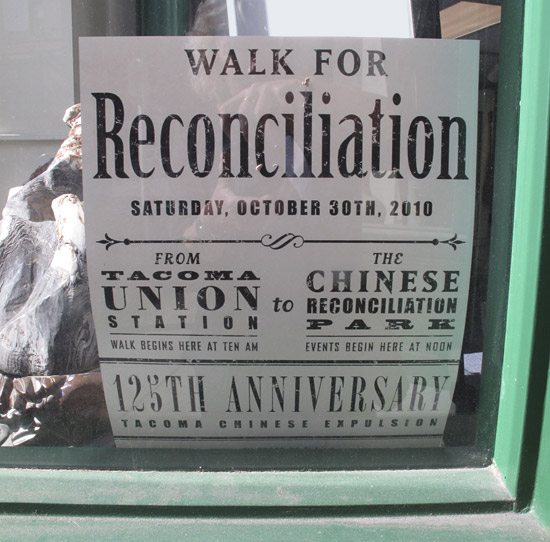
We returned to the station, reboarded Metro, and headed north back through town. Intending to get off at University Street, we overshot our stop and so, got off back at Westlake Center. We arose to street level and walked over to the Rainier Tower, designed by Minoru Yamasaki. It was completed in 1977, and I remember that people were freaked out because it appears to be like a pencil standing on its point; all were convinced it would fall over.
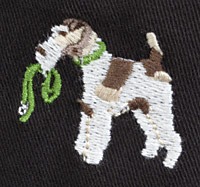 There is a long tunnel under the Tower, filled with historic photos of Seattle, Boeing and the local neighborhoods. After coming up from under the Rainier Tower, we started walking toward the waterfront along Union Street. One of the most ridiculous things I saw on our tour was a pair of pants displayed in the window at Brooks Brothers. They were embroidered with silly little doggies from top to bottom! Tell me, WHO would buy such pants? (Who would conceive of them and put them into production?!) Seeing these pants in the window stopped me in my tracks and had me laughing. Looks like this dog has his leash and is ready for a walk.
There is a long tunnel under the Tower, filled with historic photos of Seattle, Boeing and the local neighborhoods. After coming up from under the Rainier Tower, we started walking toward the waterfront along Union Street. One of the most ridiculous things I saw on our tour was a pair of pants displayed in the window at Brooks Brothers. They were embroidered with silly little doggies from top to bottom! Tell me, WHO would buy such pants? (Who would conceive of them and put them into production?!) Seeing these pants in the window stopped me in my tracks and had me laughing. Looks like this dog has his leash and is ready for a walk.
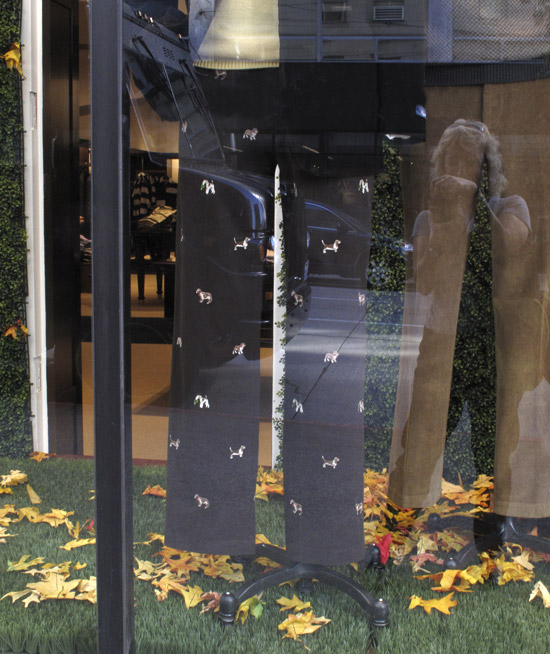
Here’s a job for the not-s0-faint-of-heart… We looked up and saw window washers on a beautiful afternoon.
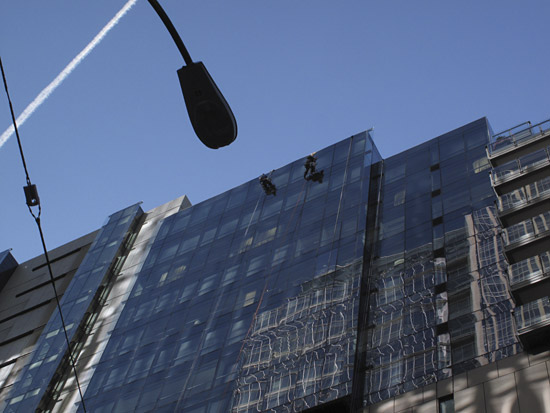
At the west end of Union Street is one of hilly Seattle’s many stairways, this one leading down toward Western Avenue and the waterfront. We climbed down, arriving at the Seattle City Light power station with its metal, floral-reminiscent barrier (instead of razor wire), and then stepped into the south end of Post Alley.
Arrive at… The Bubble Gum Wall! David had told me about it months before leaving Milano, so I was looking forward to seeing it, to which he responded: “You have blown it up beyond all expectations. It is only a 20 foot section of a brick wall between two doors on a brick roadway, with 30,000?? bubblegum wads up to thirty feet from the ground, in every color imaginable, with sculptures of gum and inserted objects. That’s all.”
The Bubble Gum Wall is at the south end of Post Alley at the Pike Place Market, accessed through a short “tunnel” roughly under The Pig by the flying fish stall.
It’s grown since David last saw it, and far outmeasures his 20 foot estimate. It’s a draw for tourists and locals alike. One girl was taking a picture of her friend who wanted to LOOK like she was licking the wall, but was terrified of accidentally touching her tongue to the wall in the process. This is THE place for portraits, cell phone cameras always at the ready.
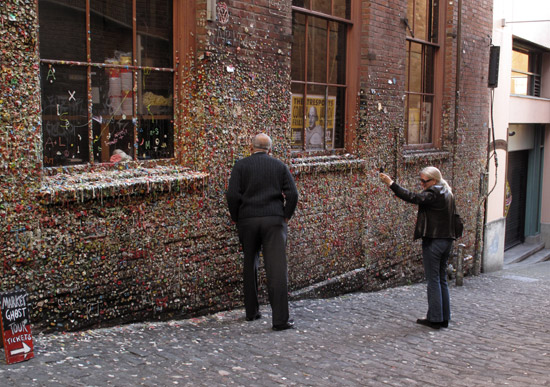
.

What is any city without it’s share of graffiti? Love it or hate it, there are times when it’s just plain gorgeous. This is rich like fabric, with its step-and-repeat stencil.
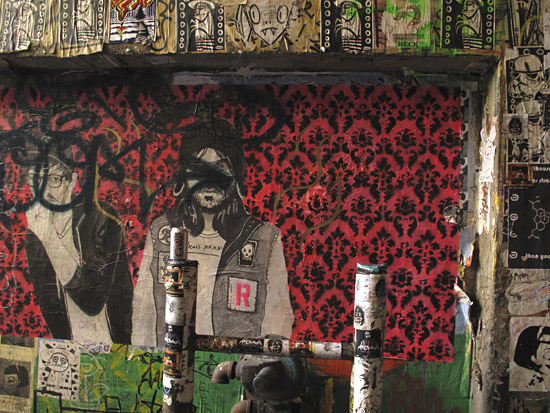
Of course, after covering Seattle, end-to-end, on foot, it was time for another pit stop and the Market was a perfect spot. There are several public restrooms hidden in the rabbit warren maze that is the Market. We went to the two that are just down the stairs from the flying fish. Black and white tile male and female figures stand outside the doors. Inside the doorway, the icons become more scientific: “XX” and “XY” figures indicate gender. (I wonder what percentage of the population knows the significance of those letter combinations.)
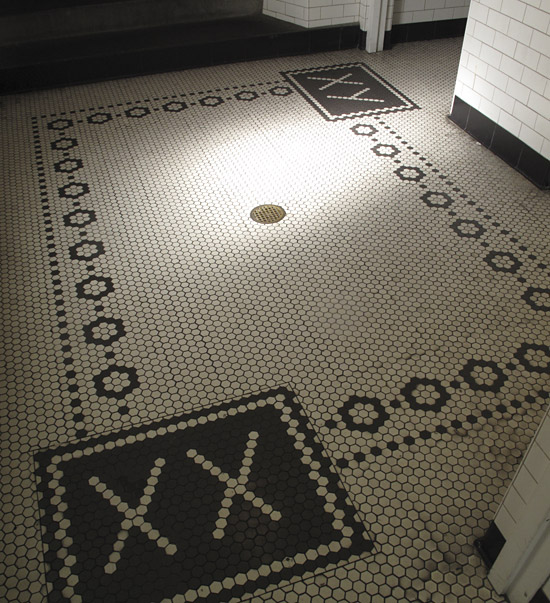
And it wasn’t until I was leaving that I realized that the wall tiles inside the bathrooms form Morse Code! Too bad I didn’t photograph the whole message.
(Update, December 21, 2010. The last time I was at the Pike Place Market (a couple weeks ago) I went back into the restroom and wrote down the full morse code message. I had only photographed the first portion of it before, which was enough to guess the meaning, but my second visit confirmed it: “Meet the producer.” Ahhh. That’s what it says over one of the fruit stands, regarding meeting and buying directly from the growers. How many people have 1) ever noticed that it’s Morse Code, and 2) if they’ve noticed, have decoded the message?)
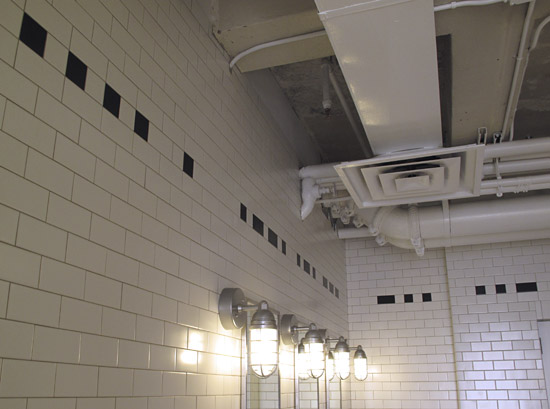
Time for a mid-afternoon bite to eat while we strolled: a half-dozen deep-fried morsels from the Daily Dozen Doughnut Company (right across from DeLaurenti’s). They tumble directly out of the hot oil, and into bowls of powdered or cinnamon sugar.
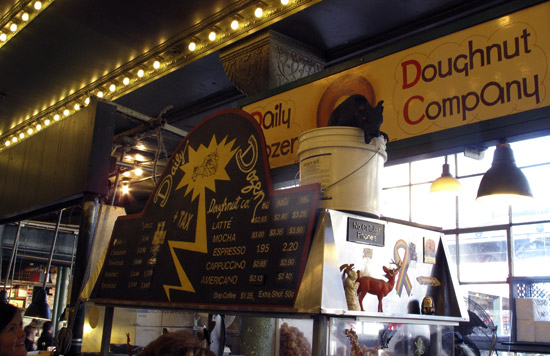
Gobbling piping hot doughnuts, we wandered to Tenzing Momo… a neighboring toy store… the belly dancers’ clothing store… and the Magic Shop. I’d been wanting to buy one of those trick balls that won’t roll in a straight line but rather wobbles aimlessly. (It’s a physical representation of how I’m feeling these days, still needing to re-establish my direction.)
This was my second Magic Shop in less than a year! The other one was Mayette Magie Moderne in Paris at Christmas time. Don’t you love the drawers of treasures in an old magic shop?
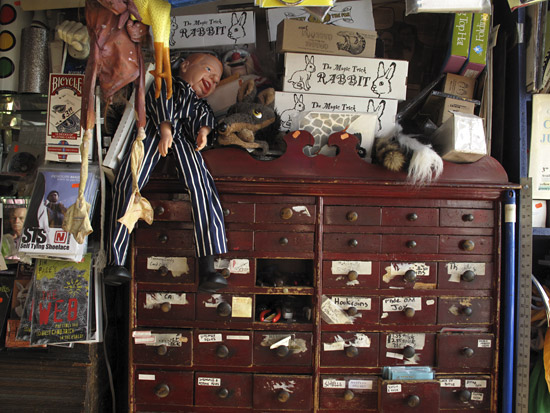
As a teenager I used to go to the Pike Place Market and wander its historic “bowels”… the many unlevel walks, ramps and stairs leading to tucked-away shops selling oddities. I still have the long strand of glass African trading beads that I bought for a quarter each. They’re worth a fortune now.
The Giant Shoe Museum is marked by a great example of the classic circus-style bills.
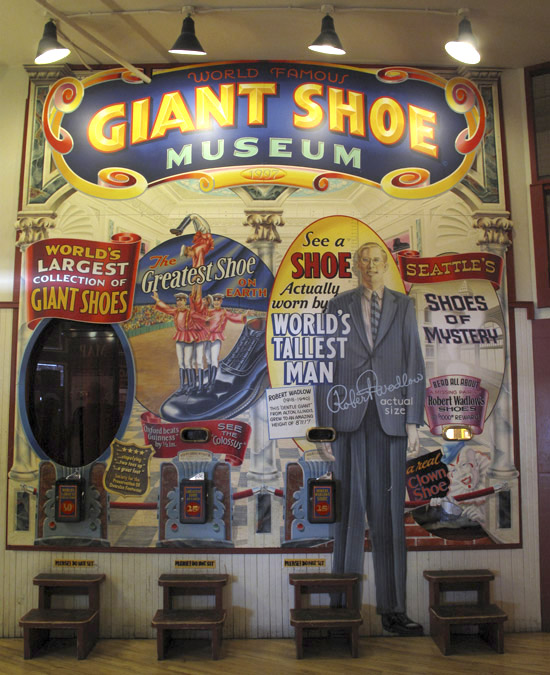
I’m amused by the visual treats that we encountered from one end of our Seattle tour to the other. Look at this light fixture near one of the Market stairways. These touches add humor and visual flavor to a city.
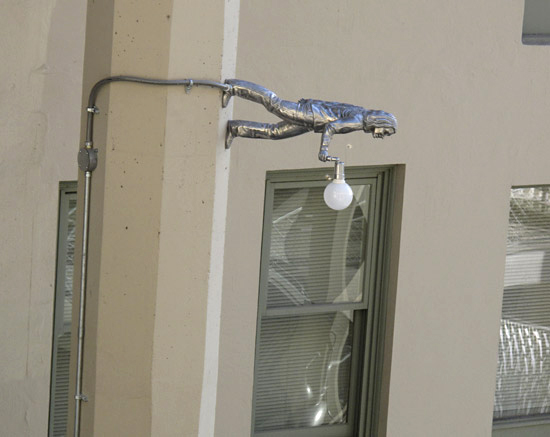
After our doughnuts had settled and we had walked past the endless food, craft and flower vendors, it was time for a real lunch. David took me to the Piroshky Russian Bakery, where we bought smoked salmon piroshky.
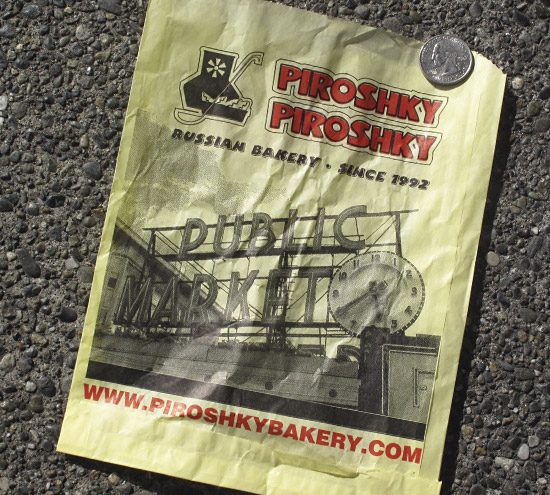
We walked to the wall-mounted tractor seats and perched there to eat and chat.
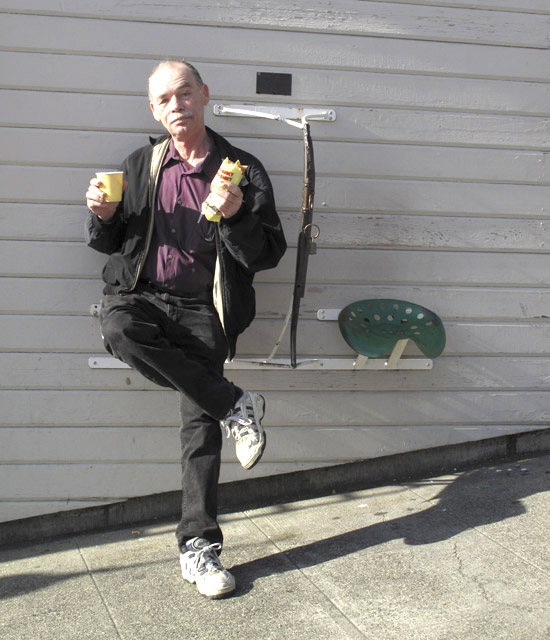
The tour was winding down, and we walked back over to Westlake Center where there was a giant chess game in progress. The fountain (to the left, below) was now flowing, so we both splashed through the tunnel of water. It’s a good thing I had put my camera away beforehand! It was much wetter than David had remembered, and I was drenched afterward.
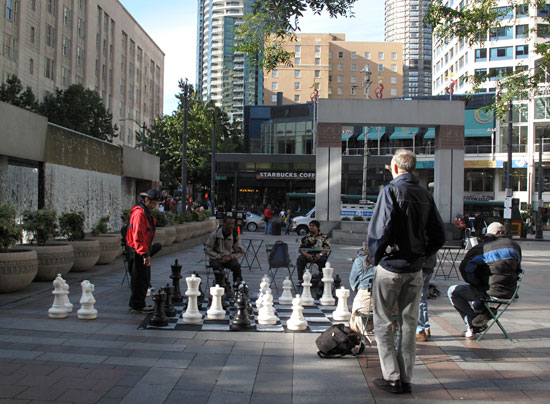
We had lucked out with a sunny, fresh Autumn day in Seattle. David and I stood on the south balcony of Westlake Center’s food court and watched the people go by.
The paving pattern is derived from a Northwest Coast Salish basket from the collection of Dr. Allan Lobb, first executive director of Swedish Medical Center (now deceased). He was the one that let me walk out of his condo 20 years ago with 4 of his 100-year-old baskets to use as photographic references for my paper models. I am thrilled every time I see this broad and beautiful paving that enlivens this plaza and roadway. (It reminds me, again, of the foreign pavers I’ve loved.)
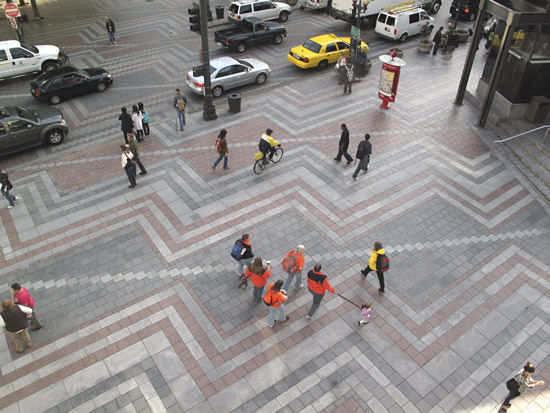
OK. Tell me. WHY would a woman be walking through the middle of downtown Seattle carrying a lifering?
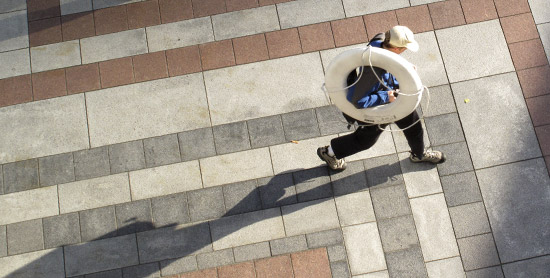
Seattle cops have two types of saddles to choose from.
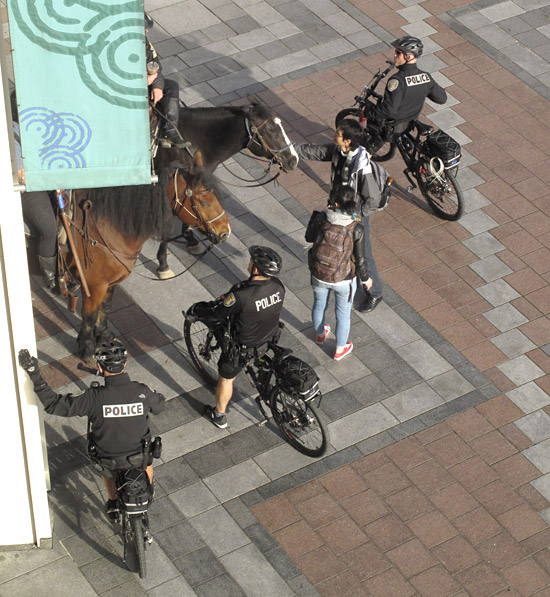
We rode the Monorail back through town, hovering over the city streets, and emerged again through EMP. The afternoon light bounced off the deep violet tiles of the museum, and colored the structures across the way. The tour was finished with a slow amble around the Seattle Center, viewing the scattered artwork in the shadow of the Space Needle.
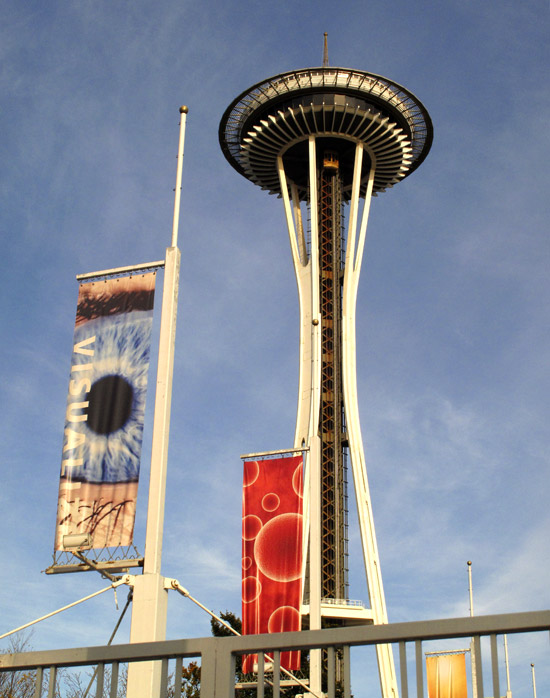
I was leaving town on a Friday evening at 5:00, getting onto the Viaduct with the rest of traffic. It reminded me of why I’m glad I no longer commute, but also pleased me with the waterside view, looking up from the roadway.
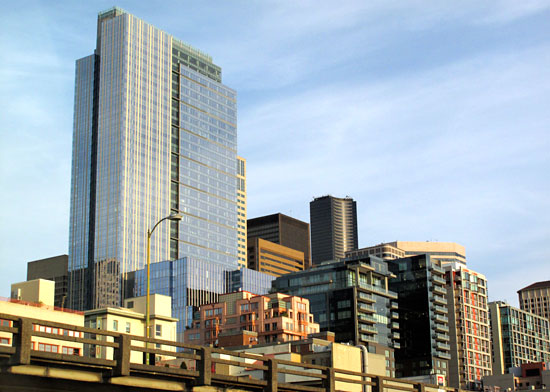
And my impression of Seattle after the day’s tour? There’s ART everywhere! “Art-with-a-capital-A”, and art in small, informal, spontaneous ways. With Seattle’s awareness of and commitment to Public Art, the city has created a visually rich flavor. Go for a walk with eyes wide open.
– – –
For those of you needing computer disaster prevention or rescue, get in touch with David. He’s saved me and my friends countless times over the years!
David Anders – The Computer Guy, Seattle
TEL: 206-286-8438 • davidanders@gmail.com • webpresenceseattle@gmail.com
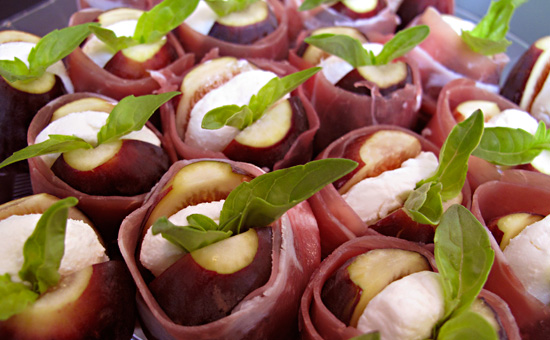
by Maureen | Oct 4, 2010 | Featured Articles, Food!, Incredible Locations, Journal, Meals, Photos, Quips, Sanremo, Seattle
The inspiration of living in Italy will likely continue on for a very long time. I recently split fresh figs and stuffed them with a wedge of goat cheese. I wound them with jackets of prosciutto slices and garnished them with young leaves of basil. The plate of appetizers disappeared in 30 seconds. Late-comers were out of luck.

When in Milano in late July, riding my bike alongside the canal, I passed many fig trees heavy with ripening fruit. I kept watching the progress, wondering if the figs would be ready before my departure on July 31. They weren’t. But at half-ripe, they were already twice the size of the the California figs I recently bought here.
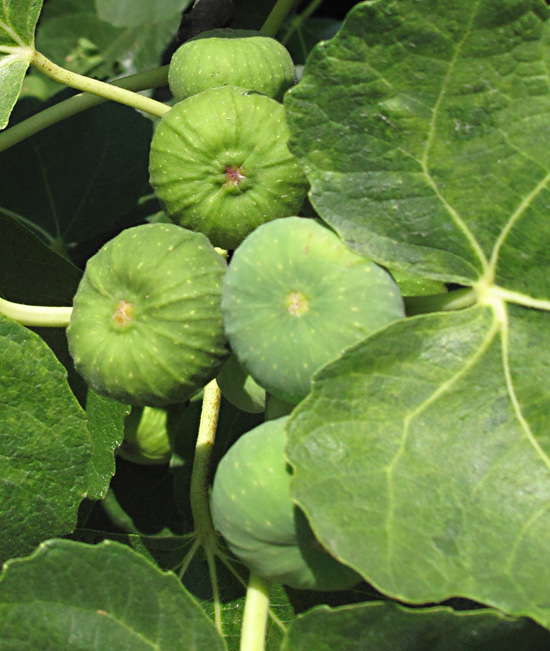
Eating figs here in Seattle reminds me of eating figs for lunch with friends in Sanremo along the Italian Riviera in early July.
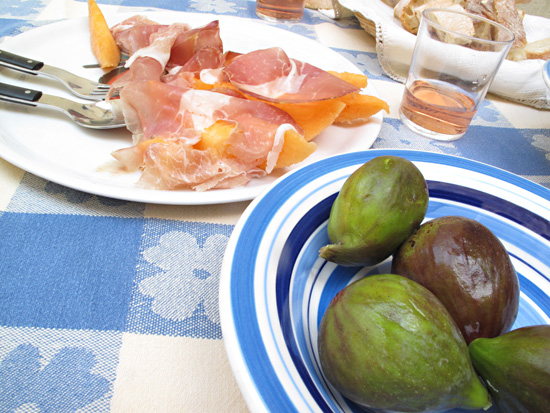
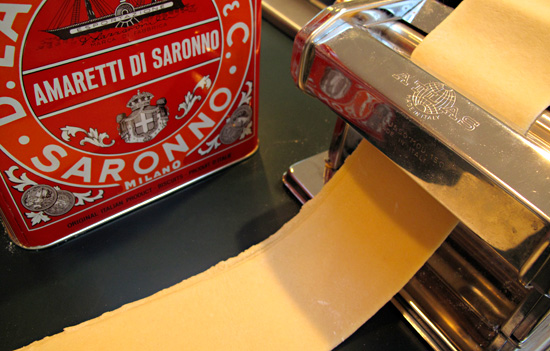
by Maureen | Sep 6, 2010 | Cheese, Featured Articles, Food!, Incredible Locations, Introspection, Journal, Meals, People, Photos, Seattle, Shopping & Markets
Seattle’s chilly summertime is winding down with scattered sunshine following cloudy mornings. Warm evenings are rare, but, once again, the waterside neighbors initiated a dinnertime potluck along the shoreline last Friday, the start of a holiday weekend. I vowed to bring “something Italianesque”, and told them I likely wouldn’t know what it would be until mere hours before I headed out my back door to cross the street.
I wanted to try my hand at making homemade pasta. Regrettably, over the course of more than a year in Italy, I never took a cooking class! No one ever took me aside to show me how to whisk an egg into a well of flour, bring it up into a dough, knead it sufficiently, roll it out and slice it into handcut noodles.
Feeling intrepid, I located “Uncle Bill’s” web site offering an ingredient list and method for “Homemades” (noodles), and found a YouTube video showing a quicker process, “How to Make Pasta from Scratch in 5 Minutes“ (using a food processor instead of the time-honored flour well). I then called my friend, Sally, and asked to “steal” her hand-crank Marcato Atlas 150 Pasta Maker.
It really did only take 5 minutes to mix up my first ever pasta dough and handcut a bundle of tagliatelle.
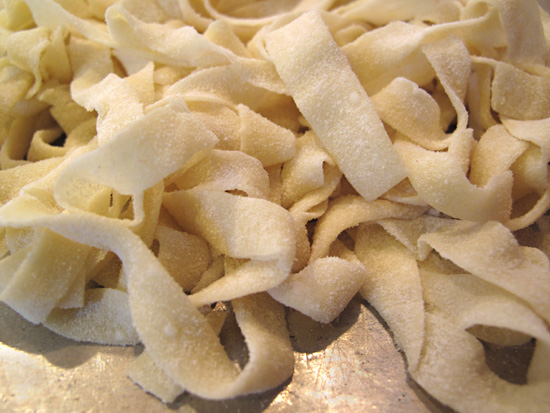
Thinking about our neighborhood dinner, I conjured a “Farmers Market Lasagna“? The day before, umbrellaed market stalls had filled the street at Burien’s Town Square and I browsed for a tasty collection of veggies to nestle between wide sheets of fresh pasta. I scouted the best of each vegetable, added them to my shopping bag, then went home to cut, grill, simmer and prepare the following:
- Grilled eggplant
- Roasted, thick-walled, red peppers
- Roma & beefsteak tomatoes, peeled, seeded and cooked down to a chunky sauce
- Caramelized Walla Walla sweet onions
- Freshly-made pesto Genovese of basil, pine nuts, garlic, extra virgin olive oil, salt and some grana padano cheese that I brought back from Milano
- Fresh mozzarella and ricotta
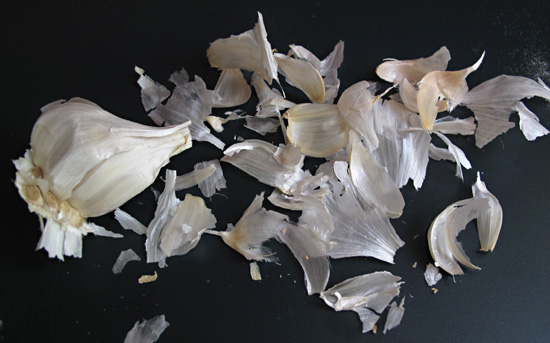
Fresh pesto is vivid green and always scents the kitchen (and the cook’s hands) with the smell of a summer garden. Making a batch, you might as well make enough for friends and the freezer! (Clean the interior surface of the jar after you’ve dished it out, then cover the pesto with a skiff of olive oil. This keeps the pesto from oxidizing and turning black, and from getting moldy. Store it for a week or so in the fridge; for longer storage, keep it in the freezer.)
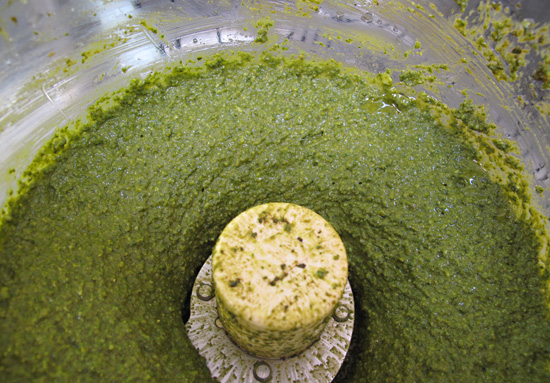
Not quite jam, pesto is still good when smeared lightly on a slice of Tuscan-style bread!
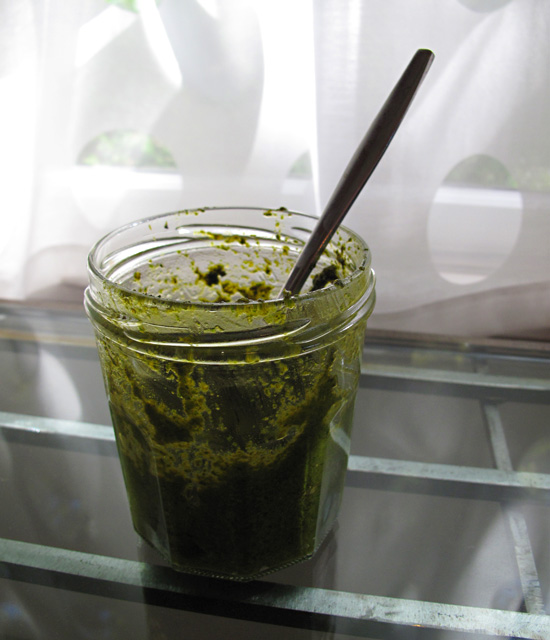
Look at the silky smooth, beautiful ribbon of pasta, just waiting to be laid down into the lasagne dish! Just a couple more turns through the finer settings on the Atlas and it was ready to go. The Milanese “Amaretti di Saronno” tin has been my flour can for close to 30 years. Prescient.

My maiden noodles were set out to dry a bit while I finished rolling and cutting. I don’t have noodle drying racks, so occasional flipping on the cookie sheets was going to have to suffice. (I love the big mess of a fully-involved kitchen!)
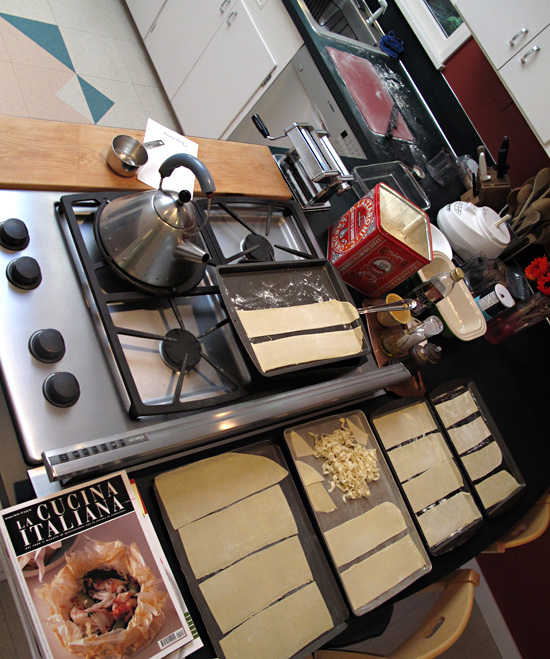
I cooked my pasta sheets in salted, boiling water for only about 2 minutes, drained them, oiled them a bit to prevent their sticking, then started the layering of vegetables and cheeses. (The smaller lasagna went into my freezer for another day. Mmm.)
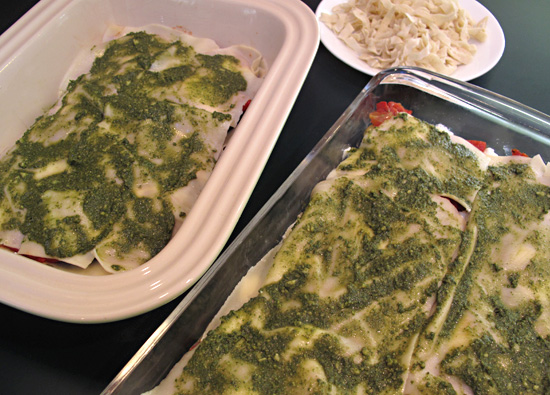
Since everything was already cooked before it went into the pan, the Farmers Market Lasagna only needed enough heat to melt the cheeses and blend the flavors. When it came out of the oven, I wrapped the dish in my apron, and carried it over to the neighbors. Eight of us enjoyed appetizers in the upper yard before winding down the wooded trail to the bulkhead beach and the rest of our dinner.
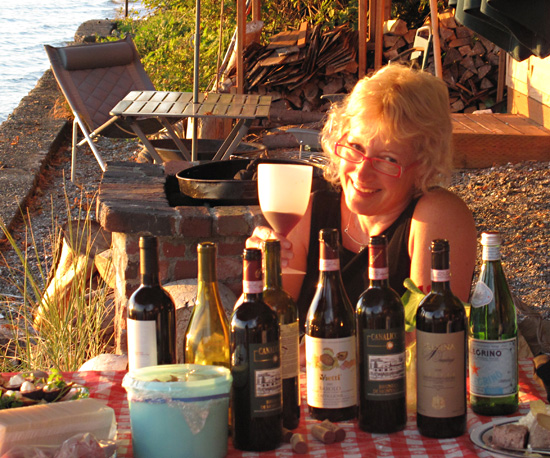
Over the course of the evening, we enjoyed an outstanding selection of Italian wines, including a Chianti Classico Riserva, Brunello di Montalcino and a Barolo! The sunset couldn’t have been much prettier.
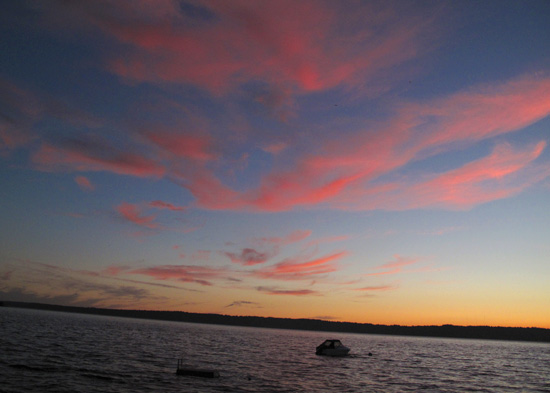
There’s nothing like a bunch of “grown-ups” sitting around a fire singing camp songs and old hymns. Barbara tried to get us headed in the right direction when singing “Row, Row, Row Your Boat” as a round.
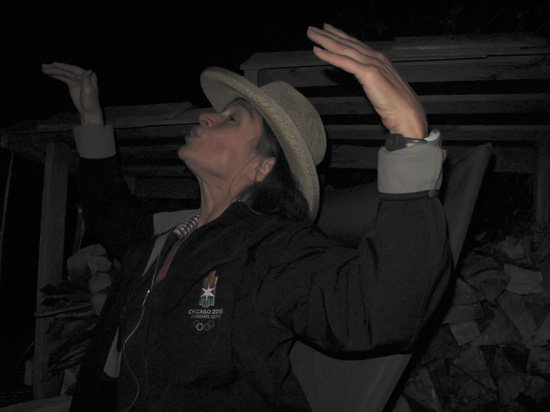
I’ve talked to many people around Seattle that don’t even know their neighbors (let alone eat and sing camp songs with them)! Returning to my neighborhood, and the friends around me here, has been one of the big joys of my homecoming.
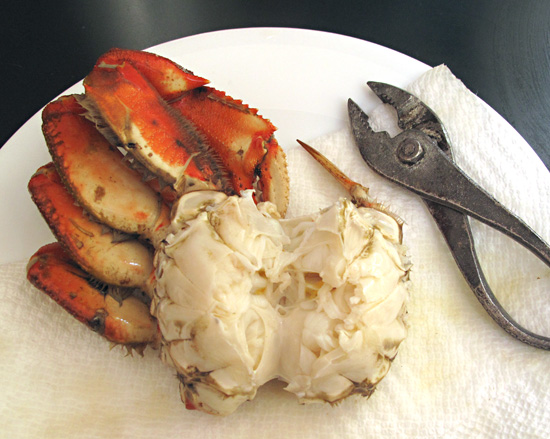
by Maureen | Aug 15, 2010 | Featured Articles, Food!, Incredible Locations, Journal, Meals, People, Photos, Quips, Seattle
“We’re having a crab feed on the beach tomorrow night. Do you want to come?” There’s only one answer for that question. “Of course!”
This is a great neighborhood: wonderful people in a beautiful setting. I’m back in this little piece of paradise with longtime friends. (I know few people that actually KNOW their neighbors; I’m fortunate that we all enjoy each other’s company.)
My waterside neighbors have been putting out crab pots lately. They pull up the pots, bring home the catch, and boil ’em up in a bucketful of water right out of Puget Sound. (It keeps the crab flavor sweet and salty.)
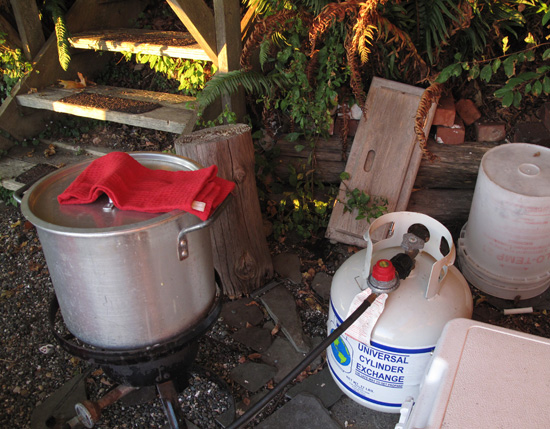
A picnic table right at the water’s edge is an ideal gathering spot.
As sunset came on, a glow was added to the scene.
Sparklers are festive any time of year.
What’s nicer than a bonfire at the shoreline on a lovely evening?
S’mores, certainly! Sally and Terry pressed a gooey, golden marshmallow into the chocolate and graham crackers for the classic campfire fare. (How long has that tradition been around? See below*)
Gary has a super-duper flashlight that casts a beam out onto the water to the boats tied there. Pretty powerful!
I can’t believe Terry and Gary sent me home with a whole crab. Can you guess what I ate for breakfast? The WHOLE thing! Those old bent pliers were the perfect crab crackers. I also use them for irrigation in my yard.
S’more appears to be a
contraction of the phrase, “some more”.
[3] While the origin of the dessert is unclear, the first recorded version of the recipe can be found in the publication “Tramping and Trailing with the
Girl Scouts” of 1927.
[4] It is unknown whether the Girl Scouts were the first to make and enjoy s’mores, but there appears to be no earlier claim to this snack. Although it is unknown when the name was shortened, recipes for “Some Mores” are in various Girl Scout publications until at least 1971.
by Maureen | Aug 4, 2010 | Food!, Journal, Quips, Shopping & Markets
What have I been having a hankerin’ for while I’ve been away?
What didn’t I find a substitute for to satisfy my yen?
White, sweet corn on the cob.
Salsa, avocado and cilantro.
Rosemary bread.
Convection-roasted, whole chicken.
Sea-salt pita chips.
Hummus.
Guess what I bought at the grocery store in the first couple of trips!
– – –
August 4 Update
For breakfast this morning, I had cajun scrambled eggs on rosemary toast with habanero mustard and American Mozzarella* cheese. Flavors I hadn’t had in a year.
*In my year-plus in Italy, I never saw the “mozzarella” I grew up with: that rubbery, dry, cream-colored cheese that Americans buy shrink-wrapped in a ball. Mozzarella in Italy is white, made of cow or buffalo milk, packaged floating in water, and bleeds fresh milk when it’s cut. Completely different foods!
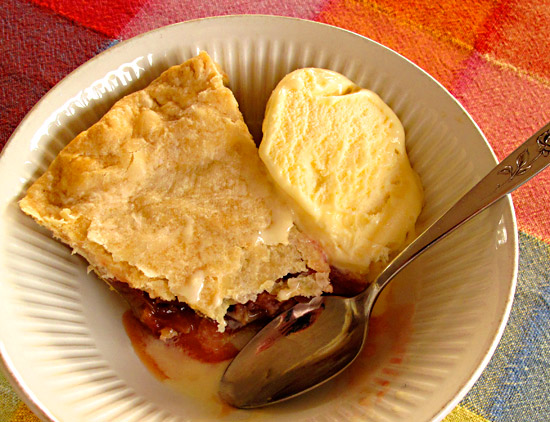
by Maureen | Aug 2, 2010 | Featured Articles, Food!, Incredible Locations, Introspection, Journal, Meals, People, Photo of the Day, Quips, Seattle
Sunday Morning. August 1.
(I arrived home yesterday in late afternoon.)
Home in the summer chill of Seattle with a 60 degree morning. I slept well with the window open to fresh, cool air. Absolute silence filled the night until the crows started talking as day dawned. No neighbor above me in spike, high heels. No garbage pickup or street cleaning outside my window.
I’m tired, certainly, but calm and relaxed and a bit in a fog. I don’t want to go into a flurry in unpacking and launch into my old routine, but rather be thoughtful and deliberate as I create my renewed life here. I have the gift of a “clean slate with a foundation”. How rare for any of us to have that (without its arising from trauma). I have family, friends, clients, continued work and a home; together they give me a solid base. But the house is nearly empty and I can start from scratch in placing things. I can choose freshly what commitments I make and activities I involve myself in.
– – –
The refrigerator was empty this morning except for a frozen tamale. I heated it up and it sufficed as enough breakfast to take the edge off for a few hours. Late morning, I walked up into Burien (I still don’t own a car) and ate fish tacos for a Sunday brunch. The tastes of spicy guacamole and pico de gallo were welcome changes.
After my morning meal, I went north with my brother and friends to Dad and Arlene’s house. We had a relaxed chat looking out to the bay, then sat for an early dinner. If ever there were a classic American meal concept, perhaps it’s the casserole. Today, our dish was chicken breasts with mushrooms, swiss cheese and a few other goodies that formed a tasty “goop” that begged for a spoon with which to harvest every bit of sauce. Our consciences were appeased by green beans with butter and cut fruit salad (called “Macedonia” in Italian.)

THEN came dessert: Freshly baked rhubarb pie with a crisco crust! What a homecoming! What a welcome! Casserole and pie. (What could be more American?)

by Maureen | Jul 24, 2010 | Aosta, Cogne, Discoveries, Featured Articles, Food!, Incredible Locations, Journal, People, Photo of the Day, Photos, Shopping & Markets
Journal Entry: 24 Luglio
The bus just left Aosta, heading back to Milano. I have been visiting my friends, Ewa and Piotr, in Cogne for two days where the “uniform” is hiking shorts and boots, muscular, suntanned legs, and walking sticks. The street signs are in French [and Italian] and at any time I can hear a half dozen languages.
The buildings have fish-scale, slate rooftops, with an undulating alignment. They all look the part of a Hobbit’s house with stone, scroll-cut wood, lichen patches and shutters.
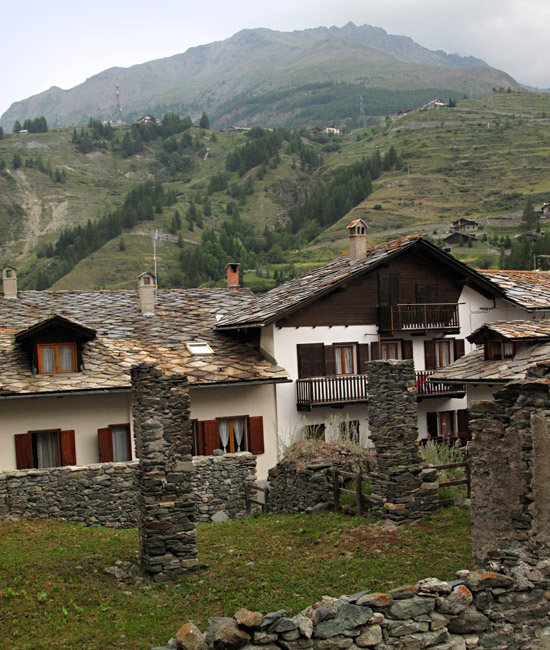
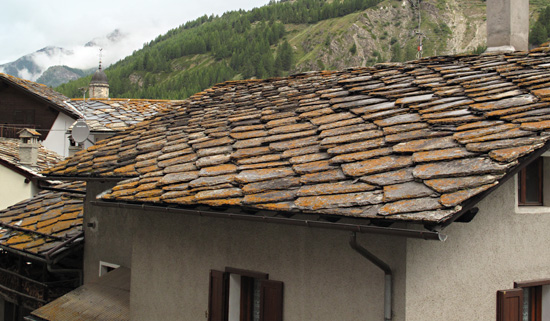
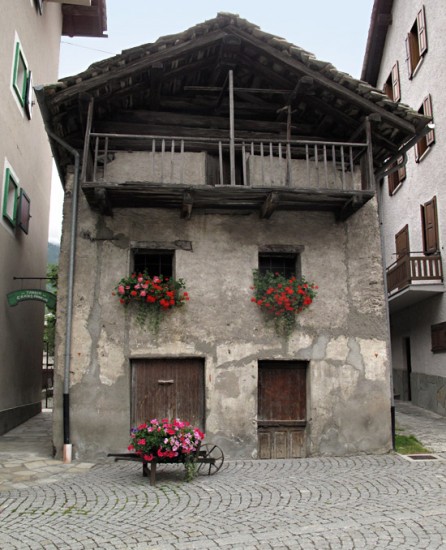
I like this old couple. I wonder how long they’ve lived in Cogne.
He’s not afraid of cherry red pants!
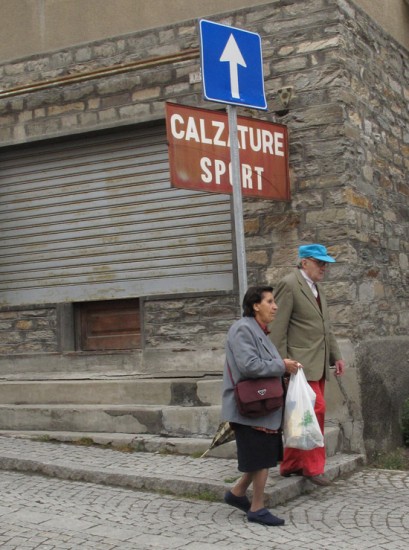
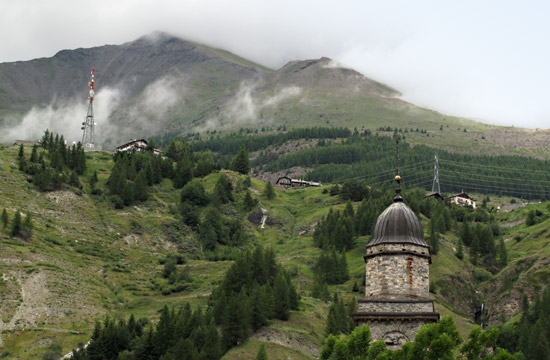
.
.
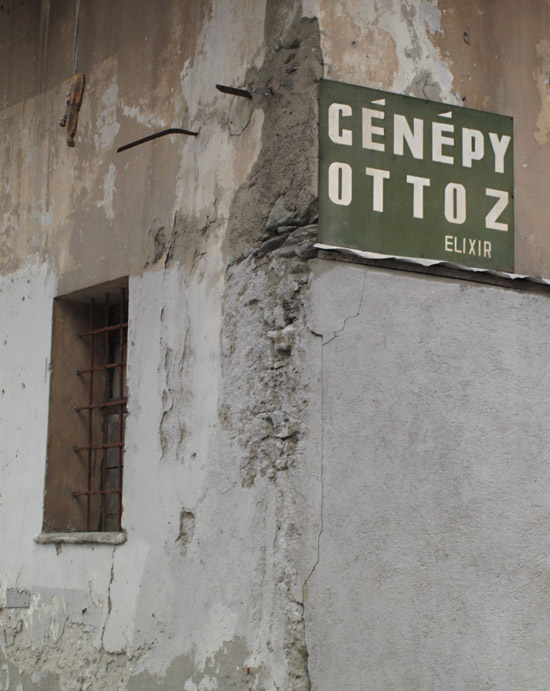
.
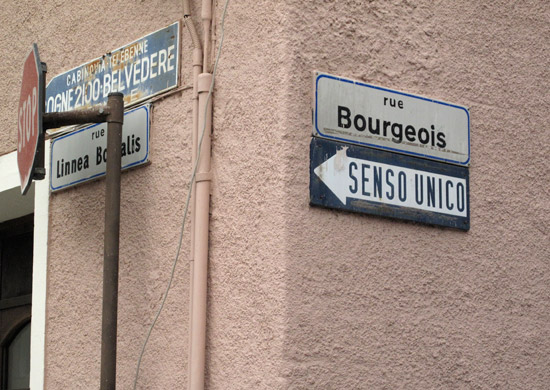
I have had to remind myself that this, too, is Italy.
– – –
Cogne draws tourists from all over Europe, especially those interested in the many miles of mountain trails and climbing routes ranging from easy-to-difficult. The town is at the start of a valley that leads to the Parco Nazionale di Gran Paradiso, the National Park of “Great Paradise” Mountain.
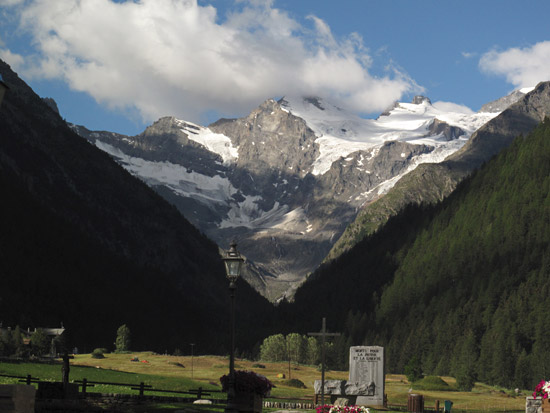
Attend the Italian School of Skiing here in Cogne.
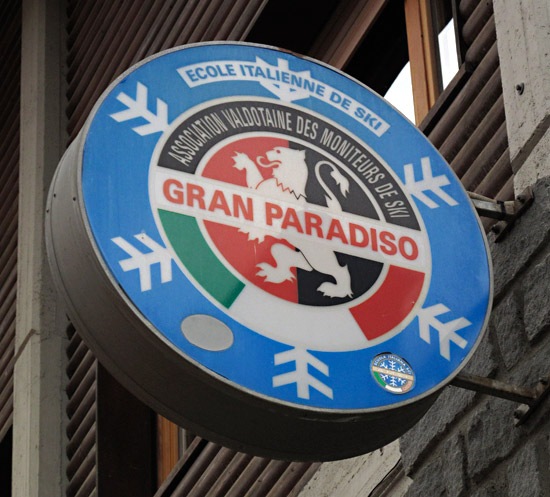
The town center is a hub of cafés, food stores, services and gift shops. Aosta’s regional bus company, Savda, makes its loop in the area at villages along the valley between Aosta and Cogne. (It also runs to and from Milano.)
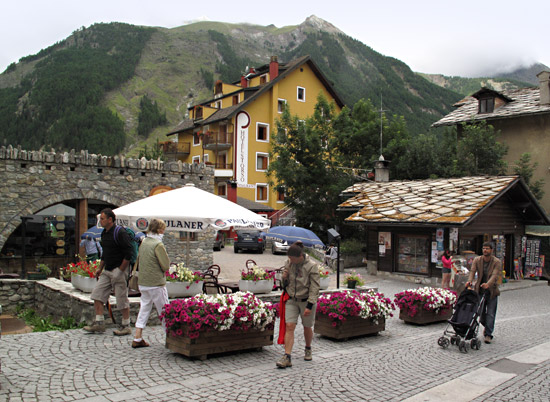
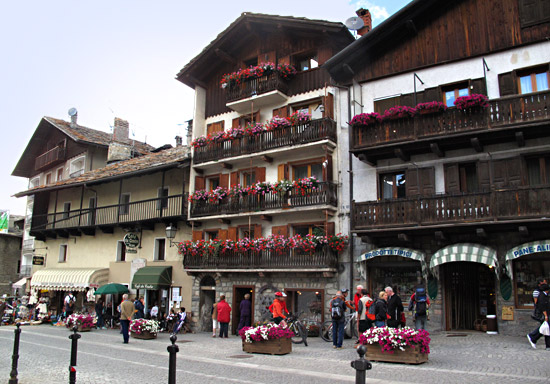
Looking north down the valley from our rented house, the view shows the one main road that passes through the few blocks of town. Parking is almost absent in the town center, bowing to the heavy pedestrian traffic, so a lower lot is available for cars and motor homes.
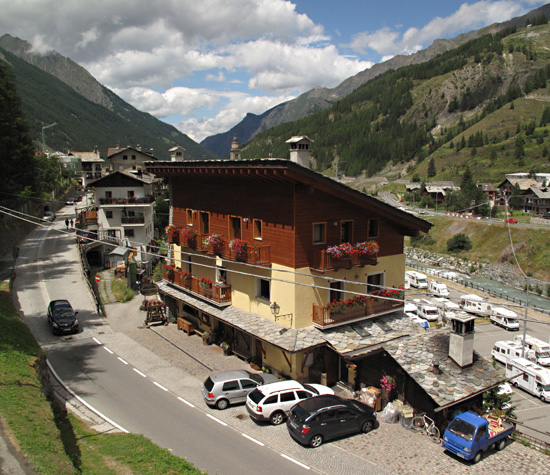
Not surprisingly, the shoe stores in town sell hiking boots and sturdy walking shoes.
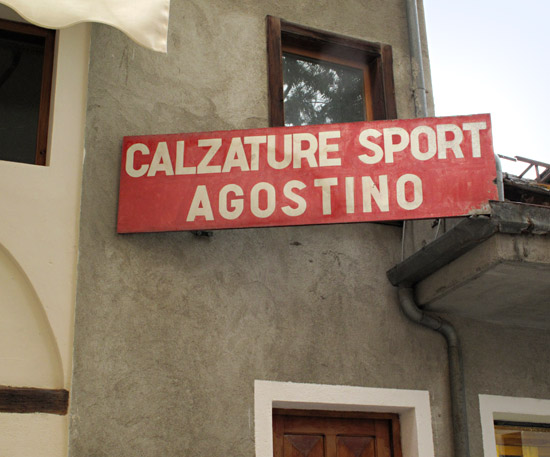
The date on the clock on the wall of the Casa dell’Orologio – Clock House – says “1806”.
And someone has an incredible salad garden going!
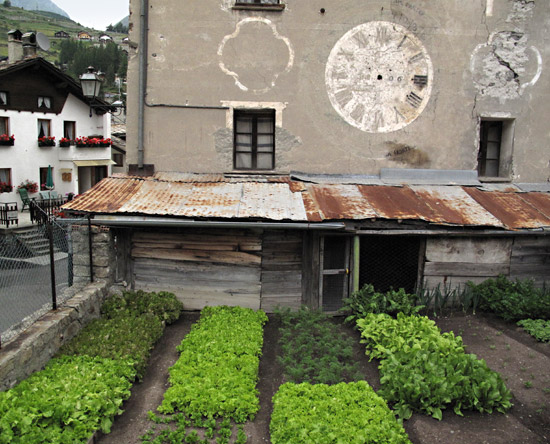
Here’s the backside of the clock building.
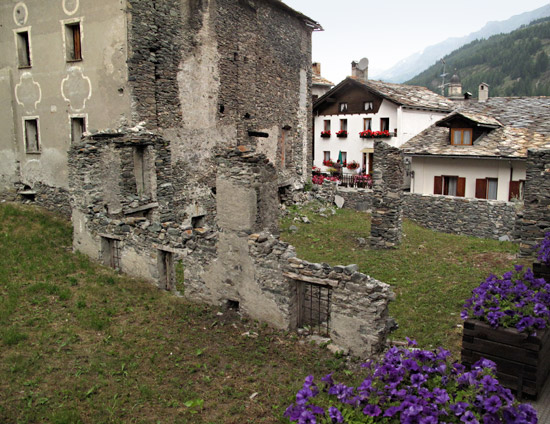
Though visitors fill the town, the locals seem to go right on with their daily lives in this mountain village, chatting with friends, sipping a caffé normale – a simple shot of espresso – or making their passeggiata – daily, walking stroll.
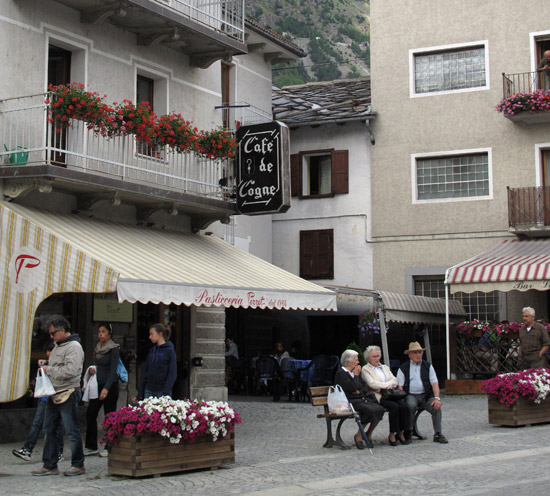
Two women were chatting outside of the small, local fruit and vegetable seller’s shop. They appeared to be locals and long-time friends.
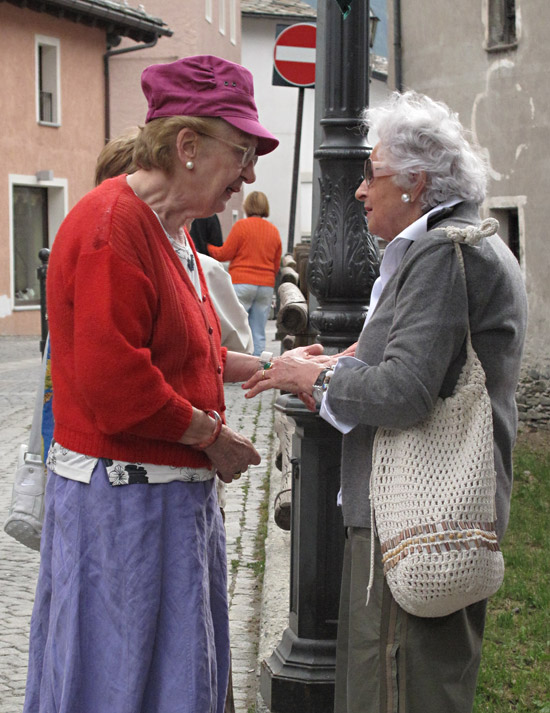
There’s plenty of lodging available, in the center of town and around its edges.
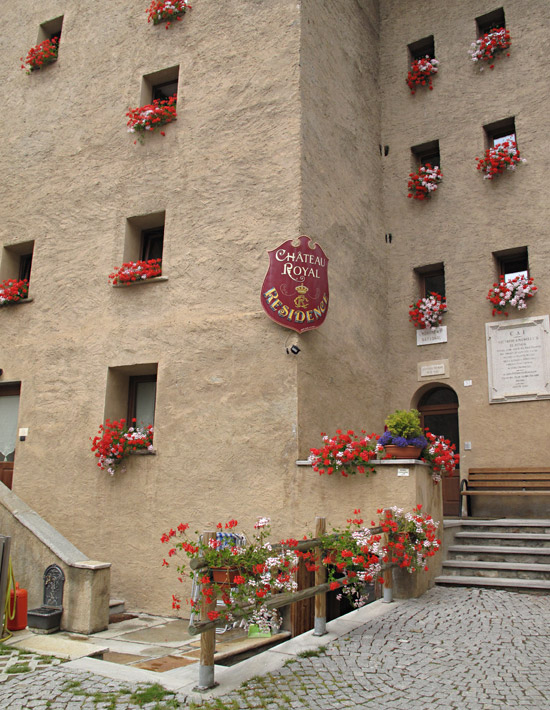
.
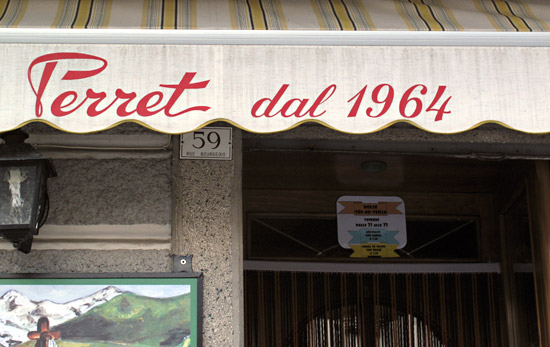
Though the town of Cogne is pristine and quaint, that doesn’t seem to be a show put on just for the tourists. I got the impression it’s always looked about like this. It’s not that Cogne is reminiscent of Leavenworth (WA), Leavenworth is reminiscent of Cogne (and other European regions).
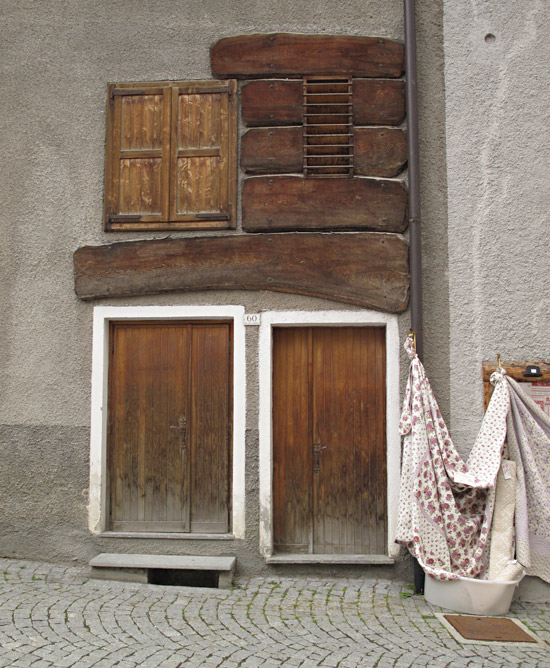
This older home is just up the valley in the village of Lillaz, gateway to local waterfalls.
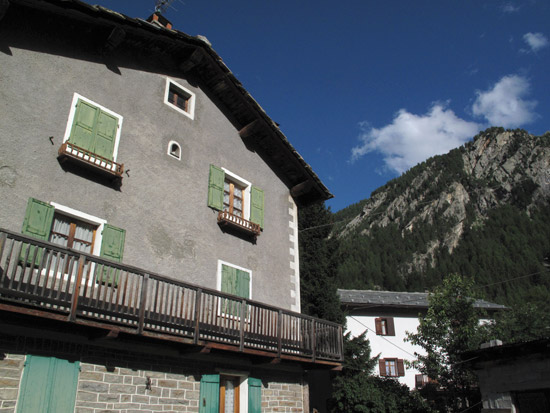
I have seen more sundials in the last year than in all of my life combined. Whether this is really from 1903 or not, it’s quite beautiful wearing its patina.
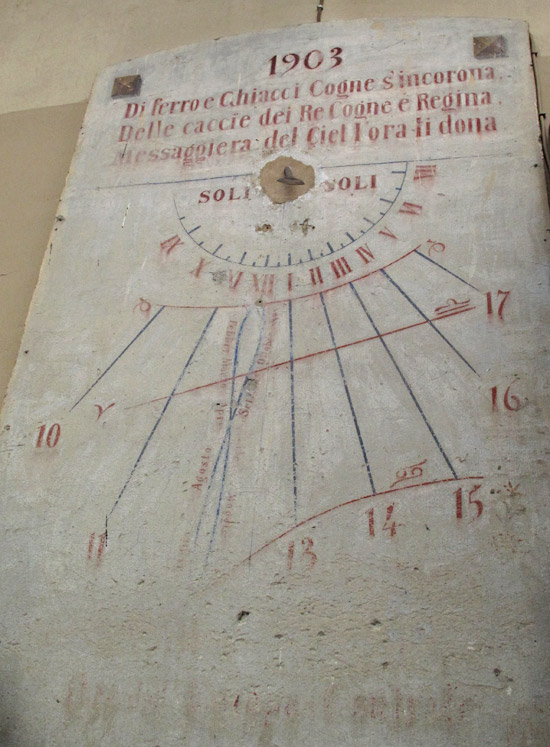
Ewa and I stopped into the local macelleria – the meat shop – to buy some meat for goulash. (She’s Polish.) The butcher scooped up a spoonful of ground, raw meat, much like a “steak tartare” and presented it to us for sampling. I reached out and grabbed a wad with my hands. It was delicious.
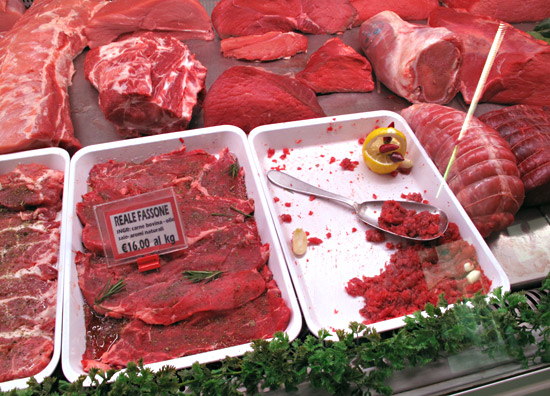
We also asked about the near-black meat in the center, (below), next to the wrapped tongue. The butcher gave us a sample, including a piece for Ewa’s 4-year-old grandson, Filippo. We LOVED it. The meat is raw, yet “processed” by being covered in hot salt. (I had wondered how it compares to Bresaola.) We bought a half dozen slices and Filippo and I fought over them as we ate the meat walking through town, licking our fingers.
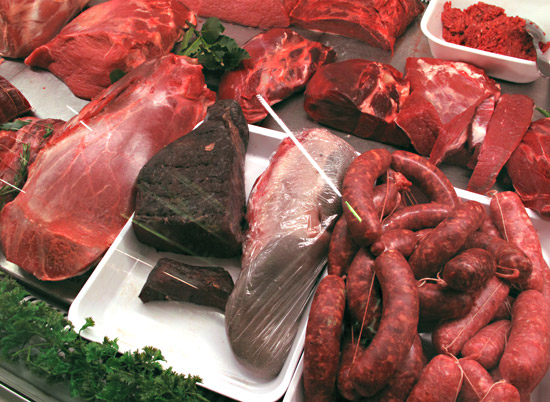
I appreciate that a “Certificate of Provenance” for the meat is prominently displayed on the counter. It tells the ID number for the animal; when and where it was born and raised; and when and where it was butchered! The next day I wanted to go back for more of the “salt-cooked” meat.
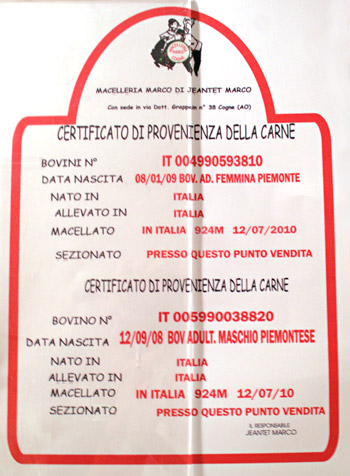
by Maureen | Jul 24, 2010 | Introspection, Journal, Quips
One week from today, at this time, I will have schlepped my bags by taxi and train to Milano Malpensa airport; checked in, with machine gun carrying guards in the mezzanine above me; gone through security; waited; flown over the Alps to London two hours north; gone through security again; eaten an airport meal; wound my way through Heathrow; boarded, gotten settled and begun my 9 hour flight back to Seattle.
I just went grocery shopping. What favorite foods do I want to eat again (and again) before I go? I bought bresaola, and mortadella with pistachios, buffalo milk fresh mozzarella, fresh figs and sicilian tomatoes. One (or two) more meals of octopus? Who do I want to see and say goodbye to? How many more last hurrahs with my girlfriends? Where do I want to go? What will wish I had photographed?
As I buy groceries and supplies this week, I have to calculate how much I can use in six days. As I go for a bike ride, or subway ride, I have to realize it may be the last one (for a long while).
From a journal entry today:
“I have grown a sweet affection for this country. It’s not the starry-eyed, naive enthusiasm of a tourist’s love of the sights. But it’s a complex recognition of the quirks, an all-too-recent connection with individuals along my path, the creation for myself of a way of being, and as yet, merely a hint of who these people are. How can I stay away for long? I am leaving a part of myself here, and have lodged a part of Italy in my heart, to carry with me. Under what circumstances will I return, and for how long?”
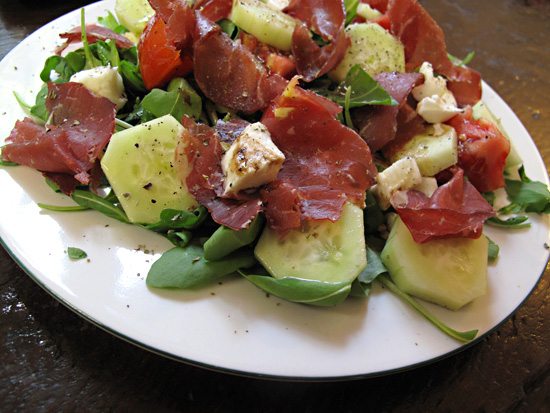
by Maureen | Jul 20, 2010 | Food!, Introspection, Journal, Meals, Photo of the Day, Photos, Quips
I’m going to miss my Insalata di Bresaola, my salad of dried, cured (raw) beef. Boo hoo. They can’t bring bresaola into the U.S. from Europe because of the mad cow disease X years ago…
But a nice salad with a bed of rucola (arugula), some bufala mozzarella (fresh mozzarella from buffalo milk), tomatoes from Sicilia, cucumbers, bresaola, some ground pepper, salt and oregano, drizzled with flavorful olive oil and a little balsamic vinegar… Be still my beating heart. Mmm, mmm good!

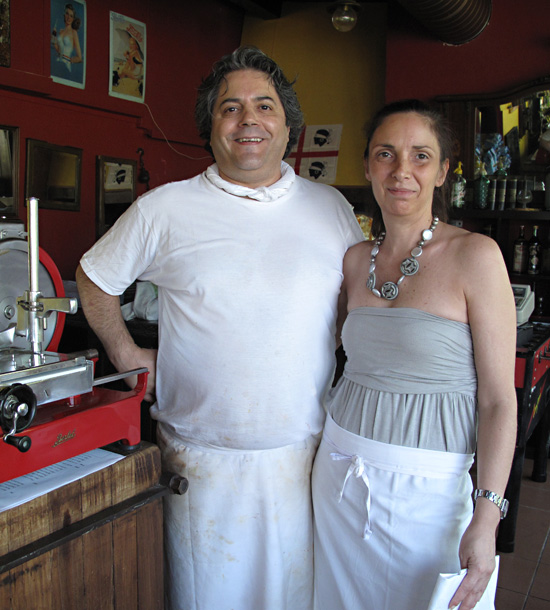
by Maureen | Jul 15, 2010 | Discoveries, Featured Articles, Food!, Journal, Meals, People, Photos
Octopus as tender as a dream, served warm and simply, with potatoes, olives and olive oil. Fish and pasta prepared and presented with an expert hand. Warm-hearted hosts, all family, welcome their guests into an easy, comfortable dining room in their restaurant alongside the Naviglio Pavese canal: Carlotta Café Bar & Restaurant. If you want to eat at all in Milano, EAT HERE.
During my year here, I have eaten at the Carlotta Café 5 times, and each time I have swooned and savored my meal. The fish could not be fresher. The light seasonings could not be more perfected. The preparation of every dish has never been pretentiously grand; it is simple, pure and complete. It’s no wonder I keep going back.
Carlotta Café owners, Ninni and Agnese, have had the restaurant for 13 years.

Siblings, Carlotta (after whom the restaurant is named) and Erik, work with their Mother in serving the café patrons. Erik is as attentive and welcoming as one could wish for when out for a nice meal.
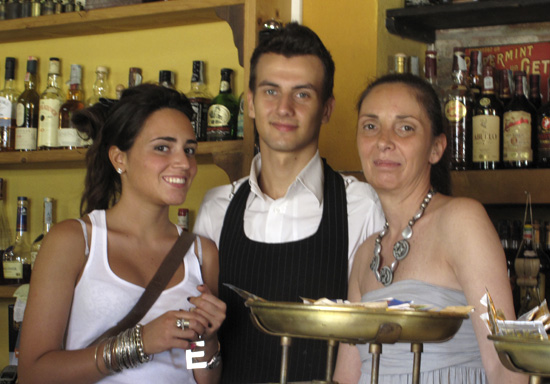
Here are a few of the dishes I’ve enjoyed in my times at the restaurant.
(The photos were taken in varying lighting conditions, evening and daytime.)
Pane Carasau, also called “Paper Music”, is a wispy-thin cracker served hot, generously drizzled with a flavorful olive oil and brightened with salt. This bread starts the meal and wakes up the mouth.
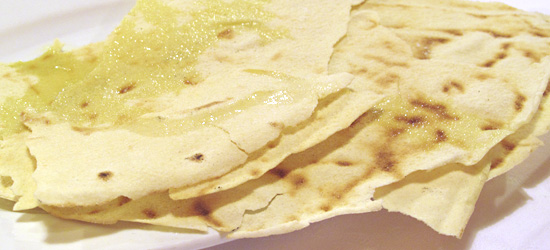
The dish that keeps bringing me back for more: Piovra con Patate – Octopus with Potatoes.
I can’t even descibe how delicious it is.
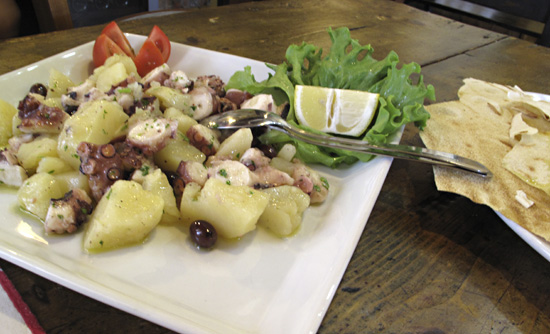
Gamberi Rossi Crudi della Mediterranea – Mediterranean Red Shrimp, served raw – are a delicacy and a gift to the palate.
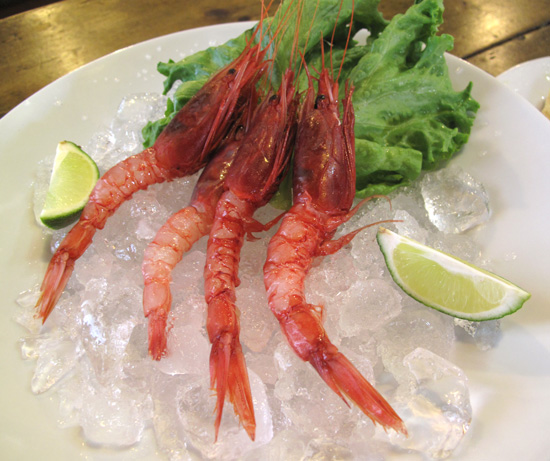
This shrimp will be splashed with lime and relished.
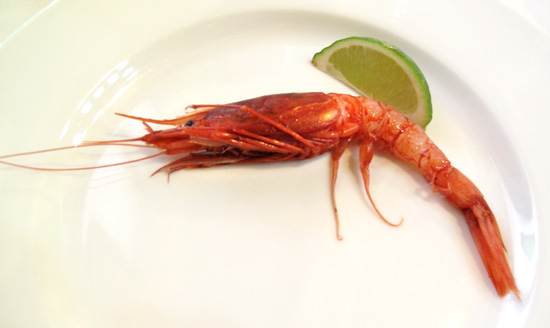
Spaghetti con Vongole e Bottarga – Spaghetti with clams and grated, dried fish roe.
Bottarga is a southern Italian gourmet specialty.
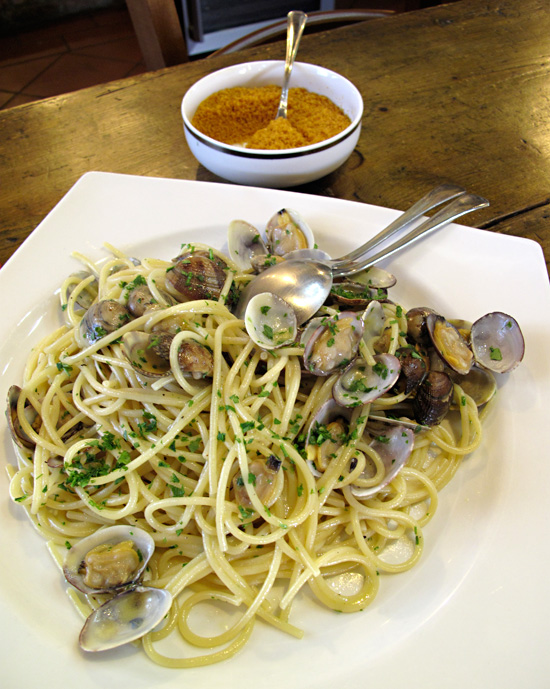
Branzino Vernaccia con Olive – Baked seabass with olives and olive oil.
Look at how beautiful those filets are. Ninni knows how to handle fish!
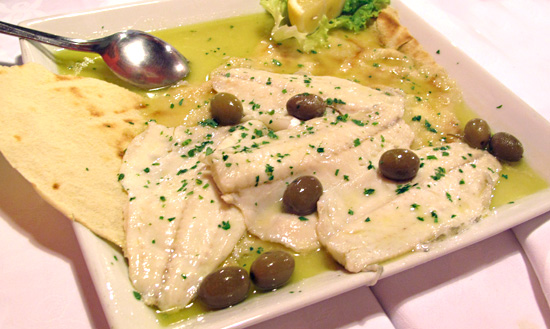
Carpaccio di Spada – Thinly sliced, raw swordfish, served with rucola – arugula – and tomato.
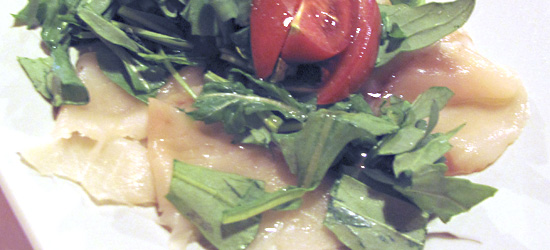
Paccheri all’Isolana – Paccheri pasta with tuna, basil and tomato.
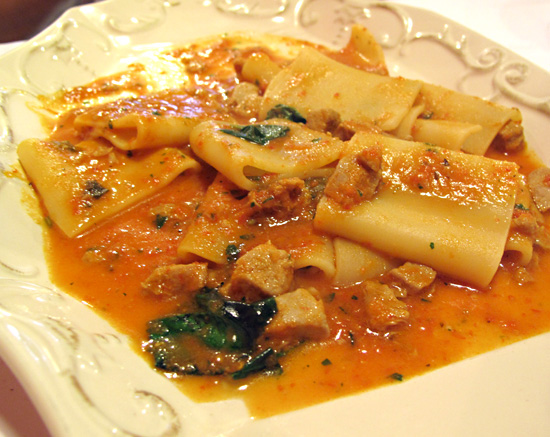
Gnocchi con Speck e Rucola – Potato Gnocchi with lightly smoked speck (cured meat somewhat similar to prosciutto), arugula and a creamy sauce.
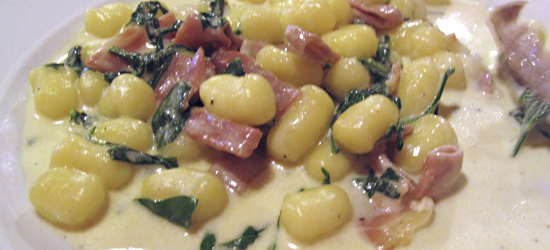
The Carlotta Café offers a full bar, wine list and caffé. Order an ice-cold bottle of Mirto, a Sardegnan specialty from myrtle leaves and berries, as a digestif to sip after your meal.
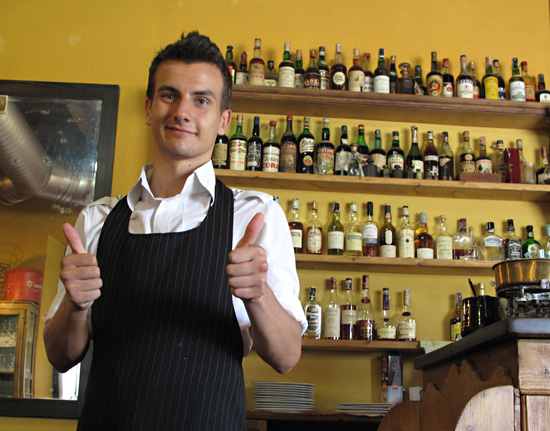
The Red Room is the quiet, more intimate room set off from the bar and main dining area.
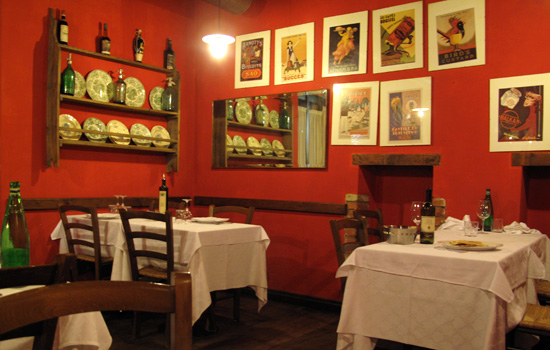
There’s also a north-facing Terrazo Room with it’s pleasant light.
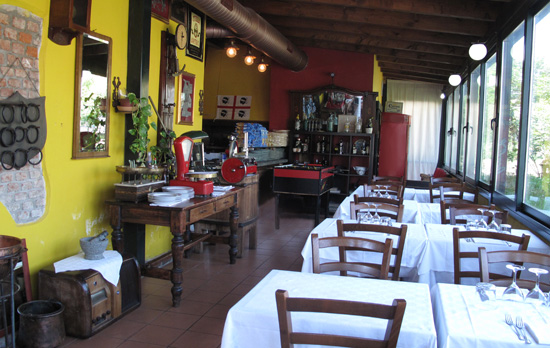
The café is not in the central hub-bub of town, and unlikely to be found by tourists. It’s not close to a subway stop and, for me without a car or scooter, it would be a long walk on a hot day. So I gladly take a quick cab ride to the restaurant and it is oh-so worth it.
Ninni and Agnese offer a “Cena a Base di Pesce“, dinner based on fish, at an incredibly reasonable price. Make it simple for yourself: order this special dinner and a nice bottle of wine then sit back and enjoy the steady stream of expertly prepared foods that arrive at your table. You will go home happily satisfied. And you, too, will dream about the octopus. (Tell them “Maureen” sent you.)
(Check with them on their current pricing, since it may change.)
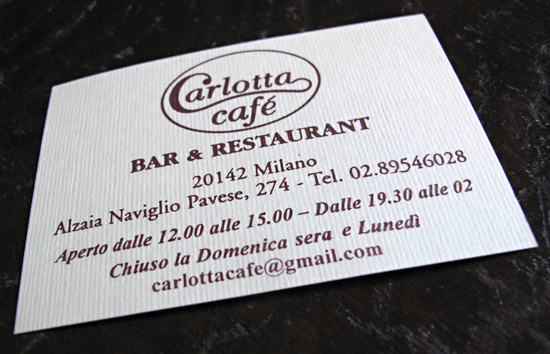
Carlotta Café Bar & Restaurant
Alzaia Naviglio Pavese, 274
20142 Milano, Italia
TEL: 02.89546028
E-MAIL: carlottacafe@gmail.com
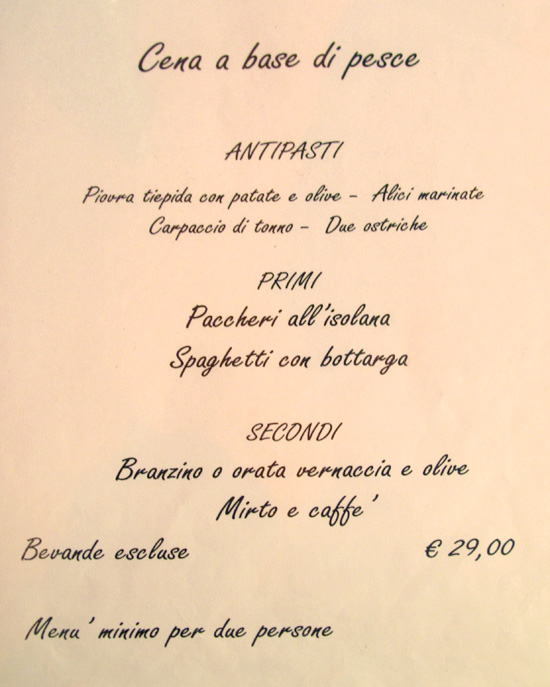















 There is a long tunnel under the Tower, filled with historic photos of Seattle, Boeing and the local neighborhoods. After coming up from under the Rainier Tower, we started walking toward the waterfront along Union Street. One of the most ridiculous things I saw on our tour was a pair of pants displayed in the window at Brooks Brothers. They were embroidered with silly little doggies from top to bottom! Tell me, WHO would buy such pants? (Who would conceive of them and put them into production?!) Seeing these pants in the window stopped me in my tracks and had me laughing. Looks like this dog has his leash and is ready for a walk.
There is a long tunnel under the Tower, filled with historic photos of Seattle, Boeing and the local neighborhoods. After coming up from under the Rainier Tower, we started walking toward the waterfront along Union Street. One of the most ridiculous things I saw on our tour was a pair of pants displayed in the window at Brooks Brothers. They were embroidered with silly little doggies from top to bottom! Tell me, WHO would buy such pants? (Who would conceive of them and put them into production?!) Seeing these pants in the window stopped me in my tracks and had me laughing. Looks like this dog has his leash and is ready for a walk.


































